So you’re interested in finding out how to visit Sossusvlei and Sesriem Canyon?
You’re in for a treat!
Our journey through Namibia spanned over two months of camping and exploring, offering us a deep dive into the heart of this breathtaking region.
Sossusvlei isn’t just another desert destination. Its spectacular red dunes and ancient landscapes make it a photographer’s paradise and a nature lover’s dream.
In this guide, we’ve packed together tips and insights drawn from our own experiences, ensuring that the advice you’re getting is tried and tested.
Ready to uncover the secrets of these stunning locations? Let’s dive in and discover why Sossusvlei is more than just a desert!
📸 Our detailed guide, How to Photograph Sossusvlei, is packed with expert tips and tricks on how to make your memories last a lifetime!
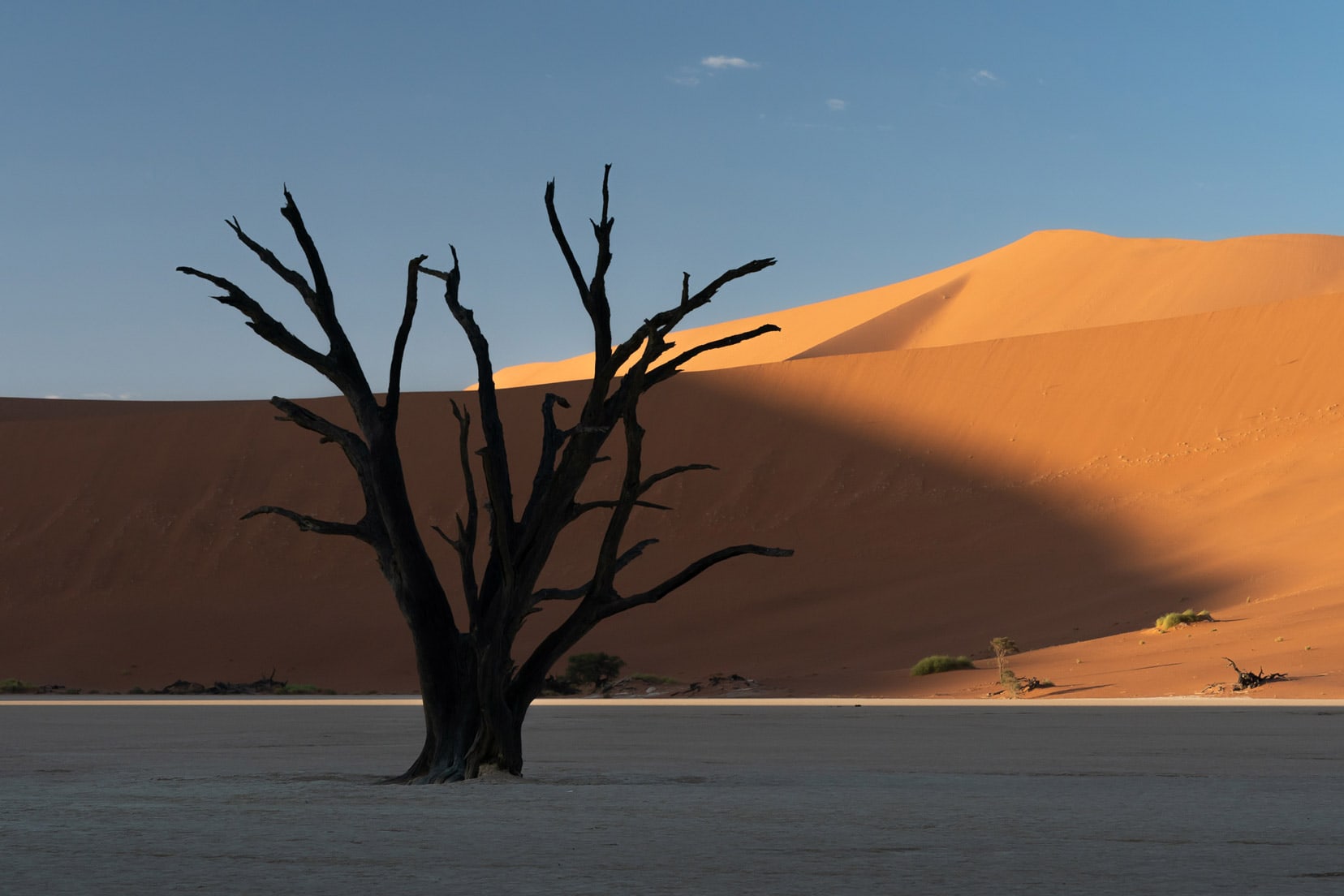
👀 What’s In This Article: How To Visit Sossusvlei
- ❗️ Key Information: How to Visit Sossusvlei
- 🗺️ Interactive Map: Sossusvlei and Sesriem
- 🛻 Tours to Sossusvlei
- ❓ How To Visit Sossusvlei
- ⛺️ Camping at Sossusvlei
- 🏨 Lodges in Sossusvlei
- 🔎 What to See and Do at Sossusvlei
- 🦒 Wildlife You May See
- ❓ How To Visit Sesriem Canyon
- 👫 Our Experience: Is Sossusvlei Worth Visiting?
- 🌦️ Best Time Of Year To Visit
- 🗓️ How Long To Stay – Our Sossusvlei Itinerary
- 🙋♂️ Sossusvlei FAQs
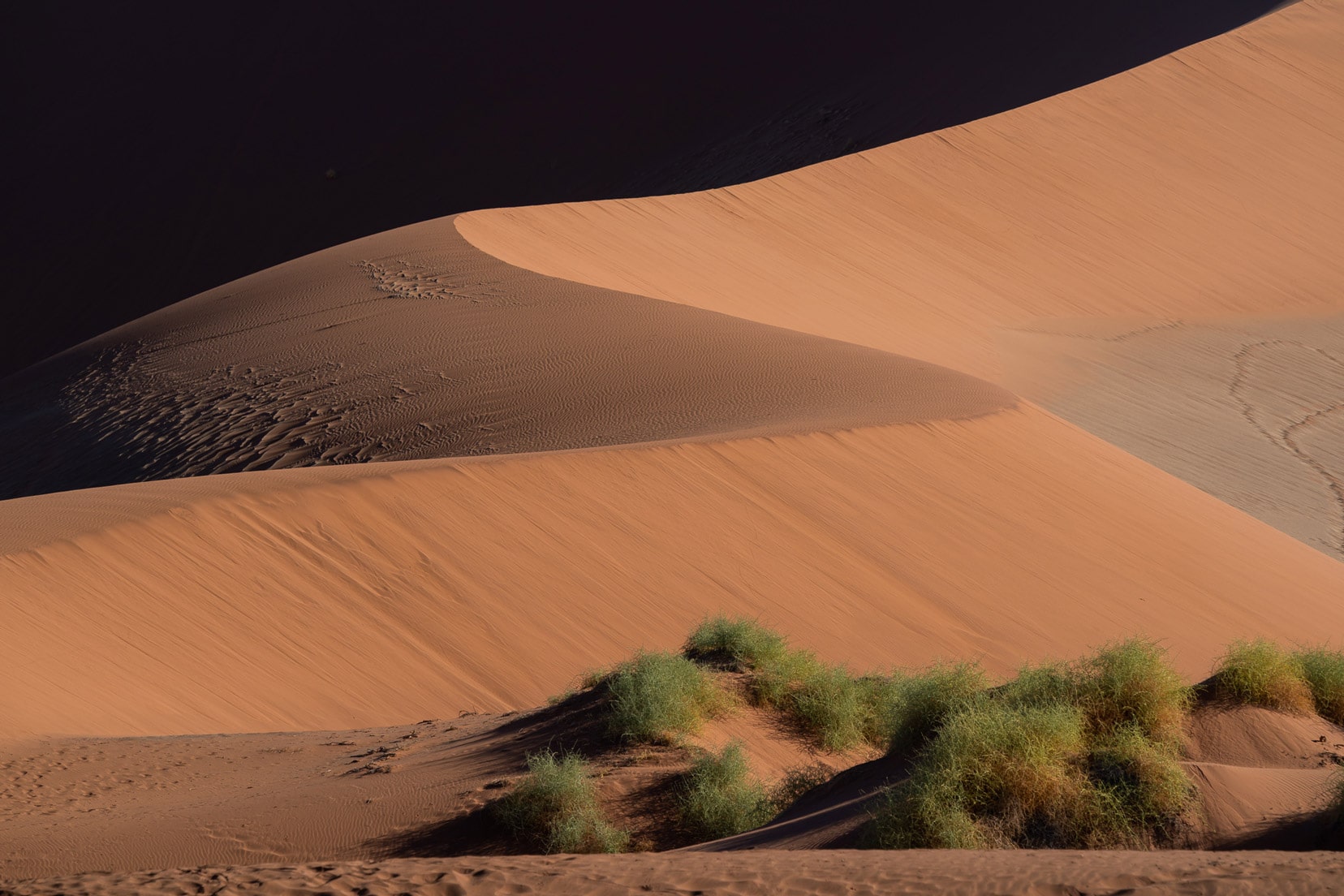
❗️Key Information: How to Visit Sossusvlei
- Location: Sossusvlei is located within Namib-Naukluft National Park, Namibia.
- Accommodation: Book a camp or lodge inside the Park (detailed reasons provided later in the post).
- Park Fees: Pay park fees and conservation charges upon arrival.
- Early Start: Plan to get up early; sunrise is the prime time to experience the dunes.
- Gate Timings: The Namib-Naukluft gate (the first gate you encounter on your way to Sossusvlei) opens at sunrise and gives access to the Second Gate into Sossusvlei.
- Second Gate Access: The Second Gate into the Namib-Naukluft Park and access to Sossusvlei opens an hour before sunrise and closes an hour after sunset.
- Queue Early: Join the queue at the second gate to enter the park right when it opens.
- Driving Options: Drive initially on tar and then sand to Big Daddy and Big Mama in a 4×4 (deflate your tyres for sandy conditions) or drive a 2×4 or 4×4 on tar and park at the Shuttle carpark 5 km from Sossusvlei and take a 4×4 shuttle the remaining distance.
- Exploration Choices: Once there, choose to climb Big Daddy and Big Mama, walk to Deadvlei and Hiddenvlei, and visit the actual Sossusvlei.
- Time Management: Be mindful that covering all these spots in one day can be challenging, especially during hot weather.
- Dune Highlights: The main dunes of interest are Dune 45, Big Daddy, and Big Mama, each with millions of years of history.
- Deadvlei: Explore Deadvlei, known for its thousand-year-old preserved dead trees.
- Wildlife Spotting: Look out for local wildlife like ostriches, oryx (gemsbok), and other desert-adapted species.
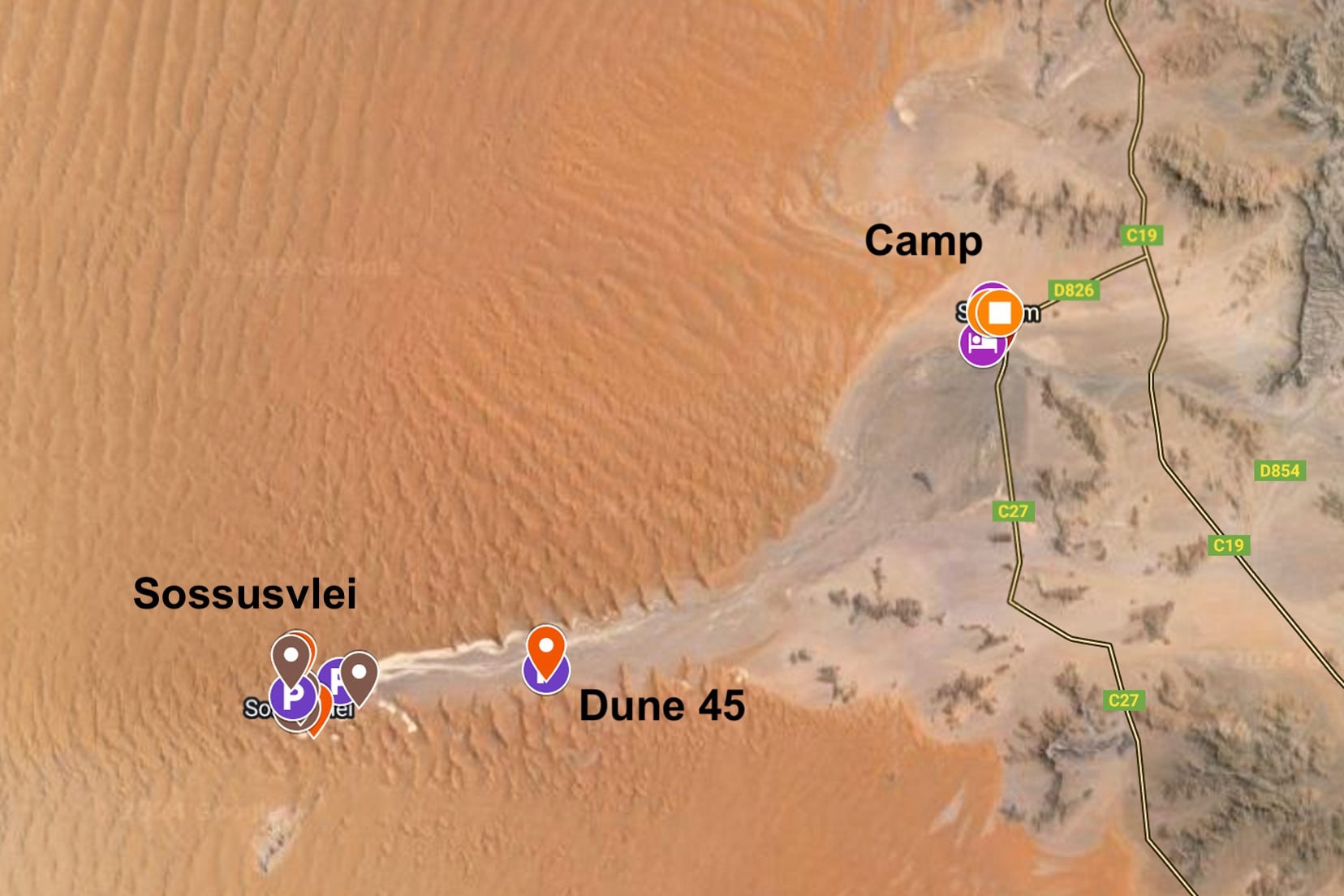
Map: Sossusvlei and Sesriem
Tours including Sossusvlei
Alternatively, you could organise a tour – here are a few that include this impressive area of Namibia:
- 🌅 3-day Trip from Swakopmund to Windhoek with Sossusvlei excursion | Check availability here
- 🐆 11-Day Namibia Highlights| includes Sossusvlei, Swakopmund and Etosha National Park| Check Availability here
- 🐘 14-day Namibia and Botswana Multi-day Tour | Includes Okavango Delta, Sossusvlei and Chobe River | Check availability here
How to Visit Sossusvlei
If you want to visit Sossusvlei, the best way to reach these iconic landmarks in Namibia is by car. The entrance to the park is accessible by a tarmac road, and from there, you can continue on a sandy track to reach the main attractions.
🚗 If you don’t have a vehicle, consider hiring a 4×4 camper from Motorhome Republic or a car through DiscoverCars.
For Namibia, we recommend a 4×4 with high clearance, though a 2×4 is suitable for main roads.
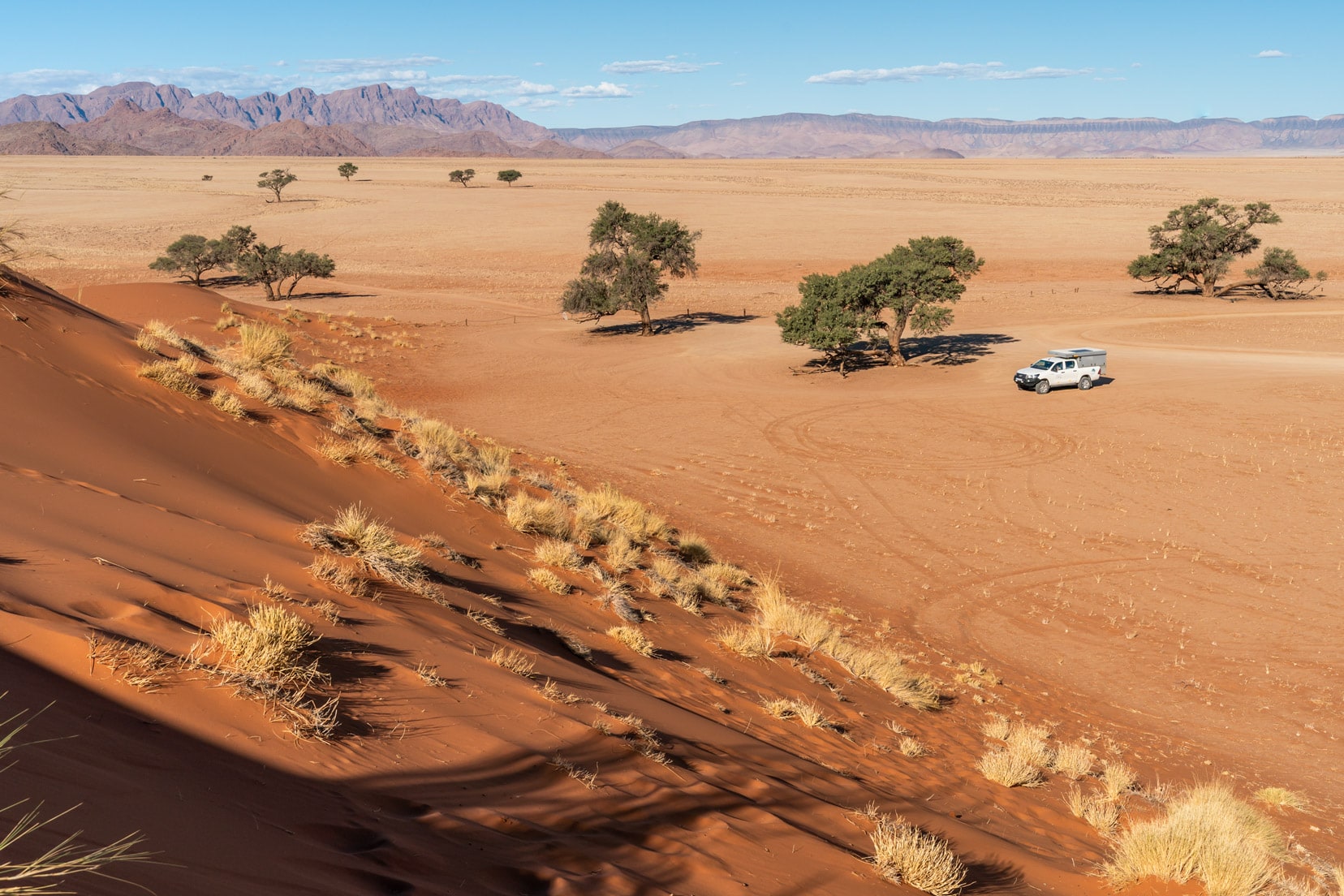
Planning Your Travels to Namibia?
- 🏥 Travel insurance: We recommend World Nomads or Safetywing
- ✈️ Flights: Use Skyscanner for flight booking deals
- 🚘 Need to hire a car? We use and recommend DiscoverCars
- 🚐 Camper Hire: We recommend Motorhome Republic
- 🐕🦺 Pet Care: Use TrustedHousesitters and have an animal lover look after your pet for FREE (Use our Discount code: LIFEJOURNEY25 for 25% off)
- 🪪 Need an International Driver’s License? Order online here
Getting to Sossusvlei
From Luderitz to Sossusvlei: 500 km, 6 to 7 hours (directly on B4/C14) or more via scenic D707.
Sossusvlei is relatively easy to get to from most areas in Namibia. We were arriving from the South in our 4×4 Hilux with a tent on top.
We left Luderitz on the coast and then stayed at a fabulous camping spot, Kanaan Desert Retreat, overlooking the vast Tiras Mountains. The campsite is just off Namibia’s much-touted scenic D707.
The feeling of being very small in a wide, open landscape stuck with me, and we were absolutely elated with our surprise find of habituated meerkats here.
From Swakopmund to Sossusvlei: 350 km, 4 to 5 hours
We were heading towards Swakopmund and stopped for a couple of nights in Walvis Bay on the way. It took about 5 hours in total from Sesriem.
If you visit Swakopmund or Walvis Bay, be sure to book a Sandwich Harbour Tour – it’s not easy to get to yourself, so a tour is the best way to see where the dunes meet the sea.
From Windhoek to Sossusvlei: 320 km, 4-5 hours
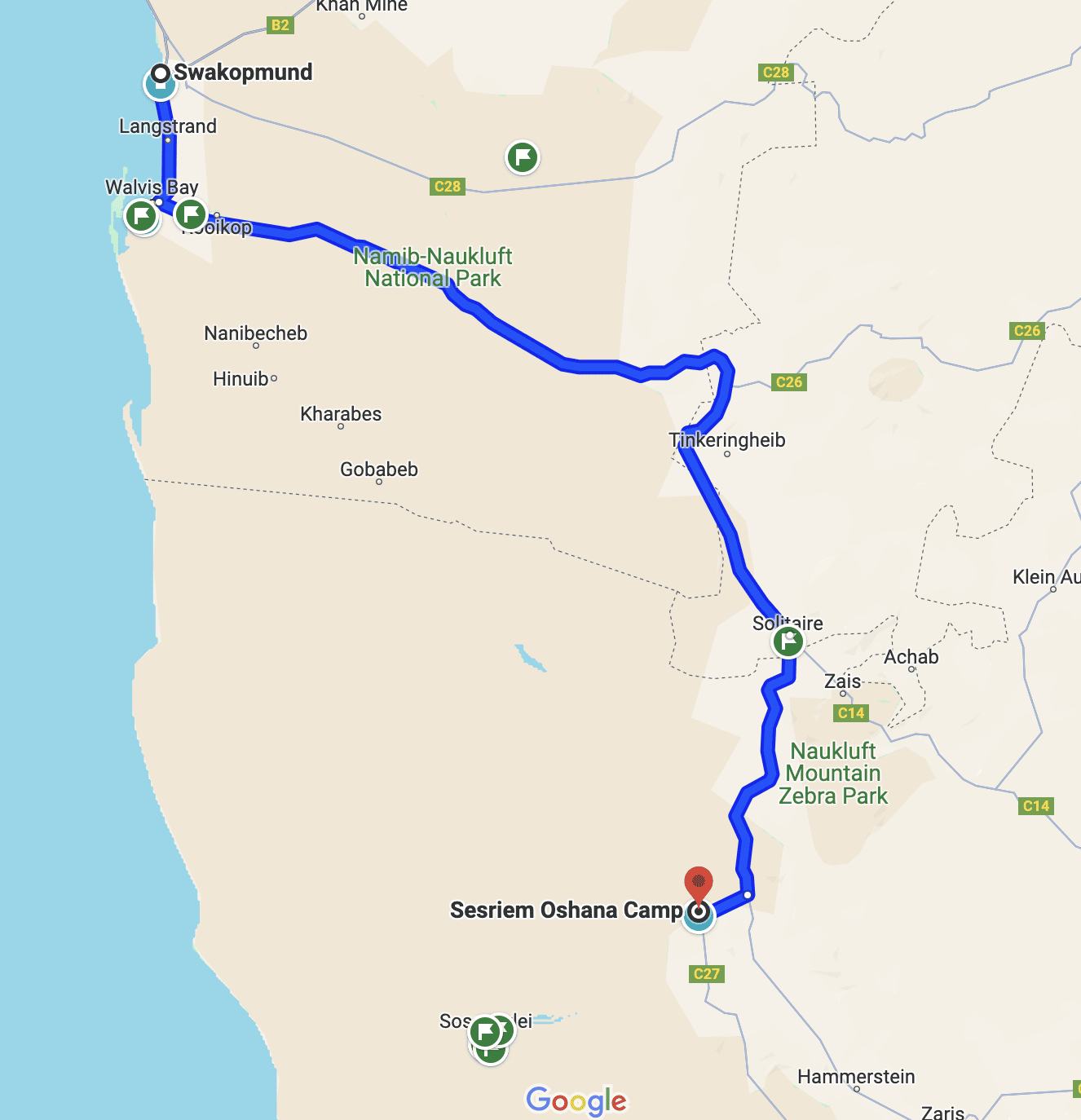
Sossusvlei Gates
There are two gates to the Namib-Naukluft Park at Sesriem, which you must pass through to reach Sossusvlei.
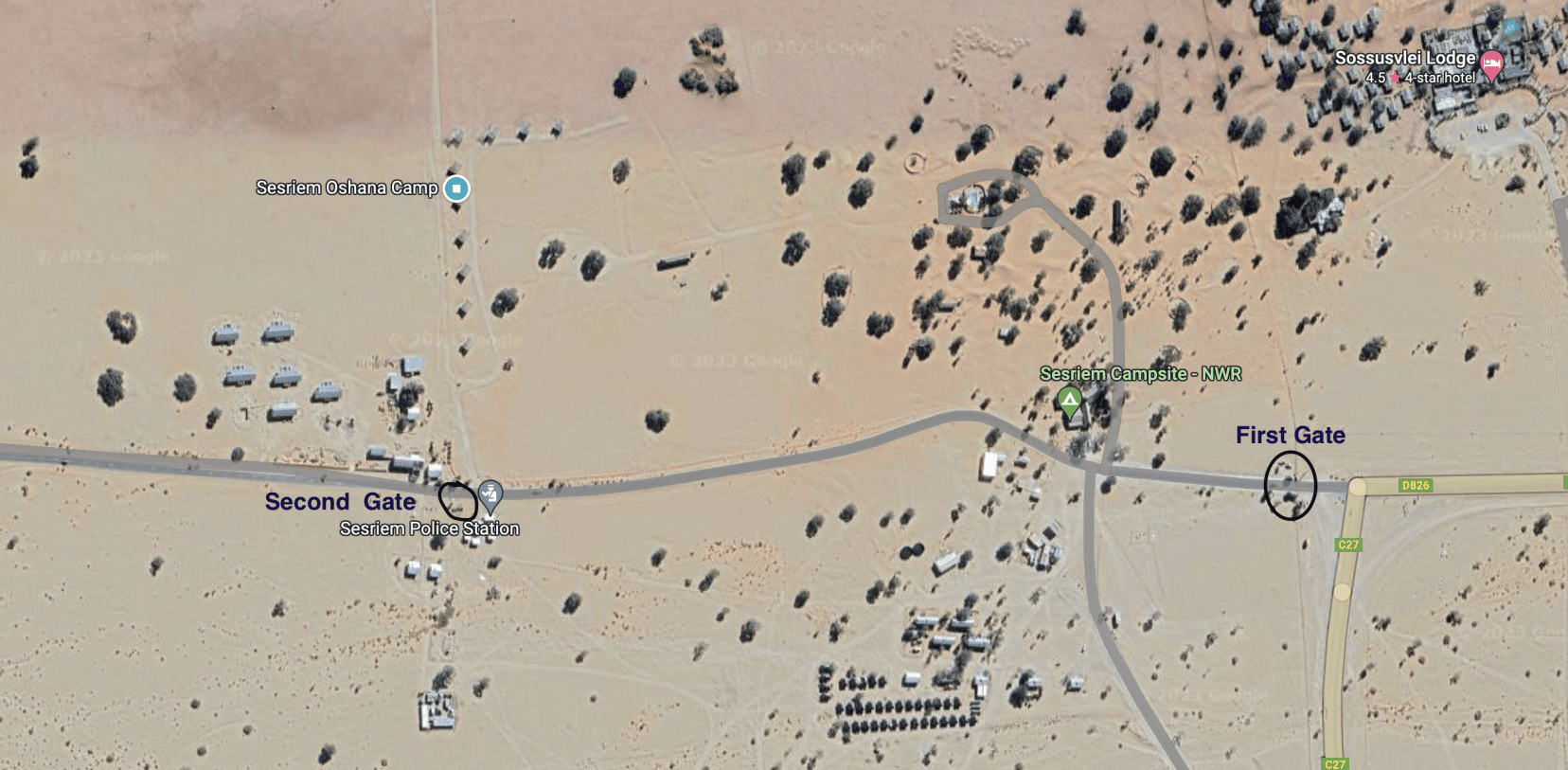
First Gate
The main gate into the park, we shall call the First Gate.
At First Gate, a guard notes down your registration number and gives you a number, which you will need to give to the NWR (Namibia Wildlife Resorts) staff member at Reception.
The reception area is to the left, just past the first gate. There you will also find Sesriem Camp, a shop and a restaurant.
When you arrive, the reception staff will collect the park entrance and conservation fees from you and provide a parking permit with a small map on the back. We had a grumpy staff member who wasn’t very helpful, but your experience might be better.
The reception staff will also tell you the Second Gate opening times (which are relative to sunset and sunrise times).
Second Gate
The Second Gate, located just past the campsite areas, opens and closes at different times from the First Gate with times based on one hour before sunrise and one hour after sunset.
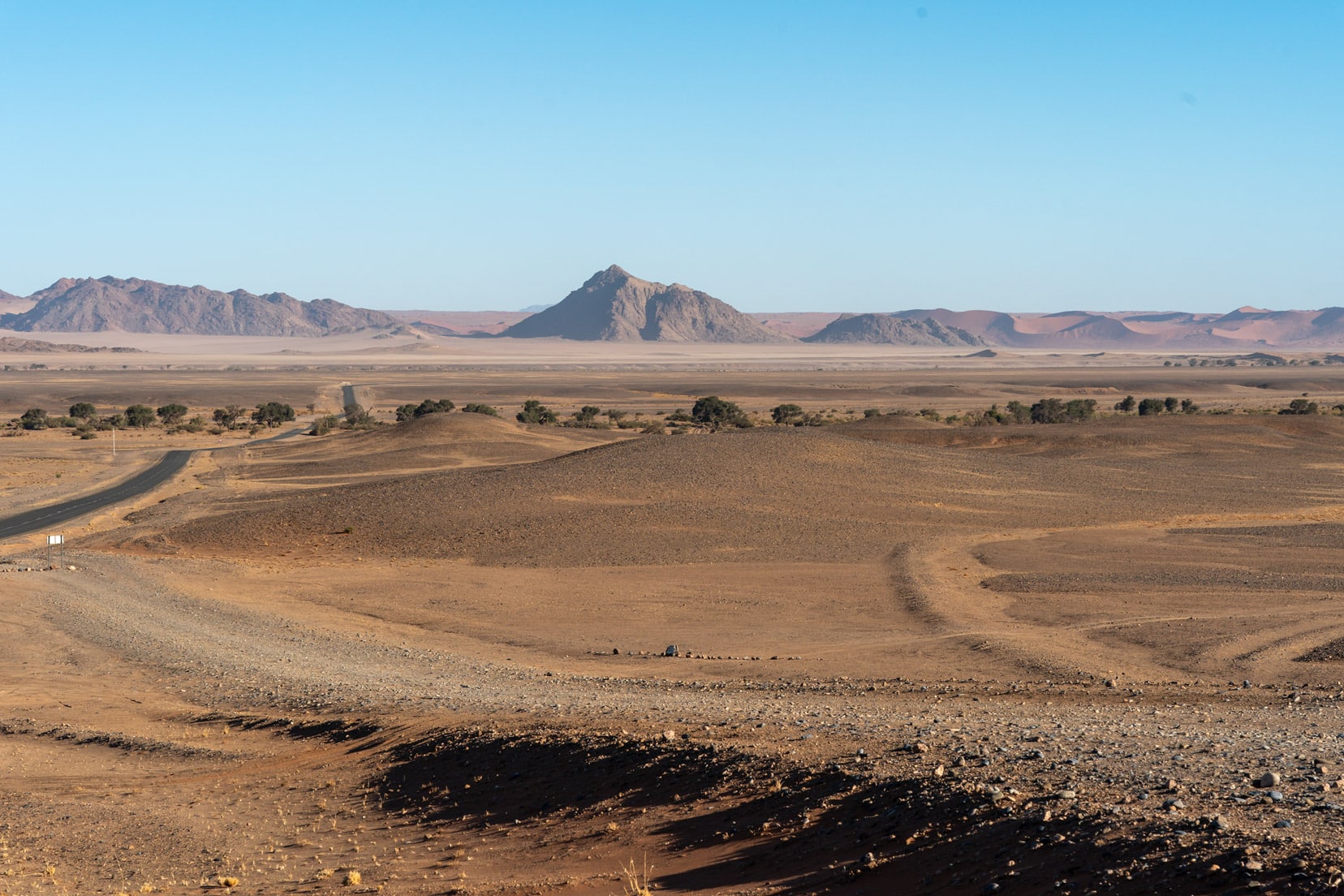
Sossusvlei Entry Fee
Sossusvlei Park fees are payable after you enter the First Gate at the Parks office desk near the reception desk at Sesriem.
Namib-Naukluft Park Charges for International Visitors:
- Entrance Fee: N$150.00 per adult per day; Child N$100.00 per adult per day (2024 price)
- Conservation Fee: N$50 per person per day (2023 price)
- Vehicle Entrance: N$50.00 per day (vehicle with 10 seats or less) (2024 price)
- Vehicle Conservation Fee: N$20.00 per day (2023 price)
Example cost: One vehicle and two people per day = N$470.00 (2024 pricing), taken from the NWR website. However, these prices do not include person and vehicle conservation fees, an extra N$70 for the two of us per day (in 2023).
We stayed two nights, so the total cost was N$700 (£38 or $47USD) in 2023 however in 2024 this increases to N$940.
Although these are the latest official park fees from the Namibian government, the document dates back to 2021, and the prices are not current.
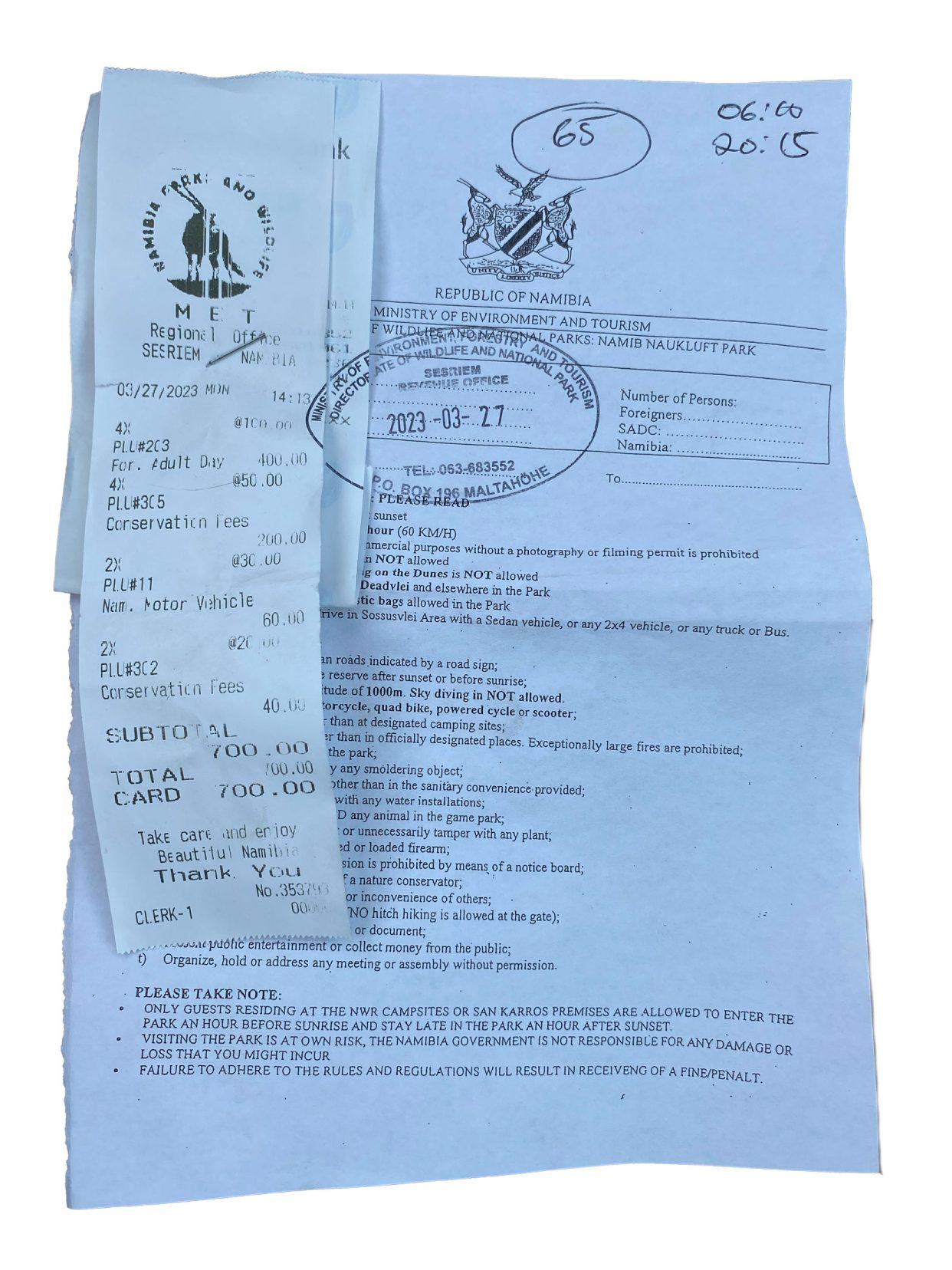
What time does Sossusvlei open?
The answer to the question of what time Sossusvlei opens depends on the gate in question.
💡Note that the gate times change in relation to sunrise and sunset times.
- The First Gate: This gate leads into the park. It opens at sunrise and closes at sunset, with gate times shifting to match.
- The Second Gate: Inside the park, just past the campsites, opens one hour before sunrise and closes an hour after sunset.
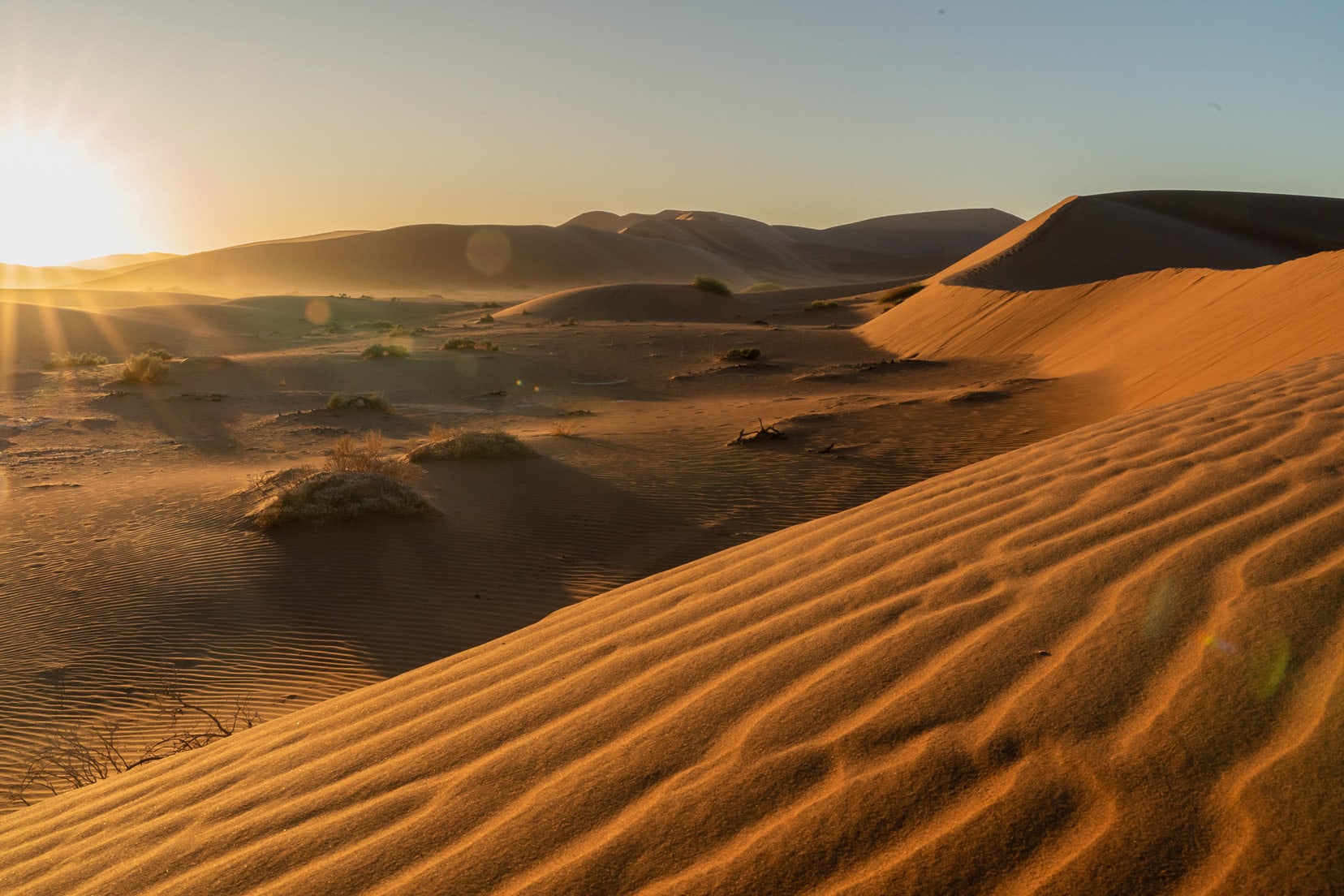
Getting to the Sossusvlei Dunes
If you are staying inside First Gate, at either a campsite or Lodge, you can enter the park for your drive to Sossusvlei an hour before sunrise and leave an hour after sunset.
If staying outside of First Gate, you will be able to enter the park at sunrise and must leave before sunset.
The tarred road to Sossusvlei takes you between many dunes. You will pass Dunes 40 and 45 on your left. Aptly named as they are at the 40 km and 45km mark from the gate. There are small car parks at the foot of each.
Once you arrive at Sossusvlei’s gravel parking area, you can either take a 5km hike, hop on a shuttle or drive yourself in your 4×4 to reach the famous red dunes and salt pans.
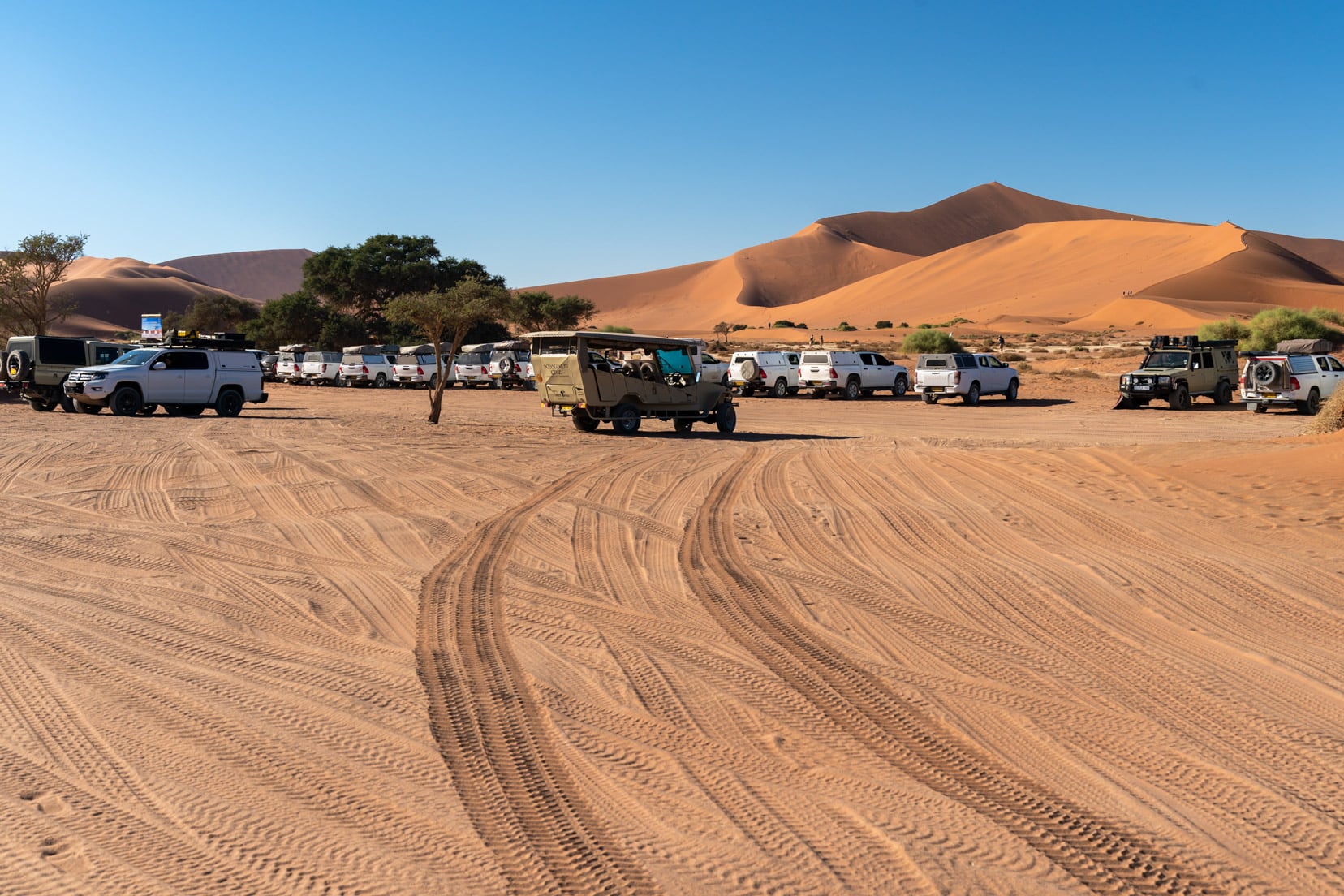
The main attractions:
Big Daddy and Big Mama, Deadvlei and Sossusvlei are about 60km from the Second Gate.
Shuttle Costs:
A constant shuttle service runs from the car park to Sossusvlei, costing about N$180 per round trip per person.
Driving Yourself:
If you have a 4×4, you can drive the extra 5km yourself. Note that this section is deep, soft sand. Deflate your tyres.
We didn’t realise that the route would be so sandy, and on the first morning, we didn’t let our tyres down enough and slower traffic in front caused us to lose speed.
Yes, you guessed it!
We got ourselves bogged!
You don’t want that happening when you are in a hurry to beat the sunrise, so do take the extra few minutes to deflate in the car park before venturing off road.
Getting bogged here, though, set us in better stead for driving the dry riverbeds further north in Namibia; we were much more aware of taking the time to deflate our tyres!
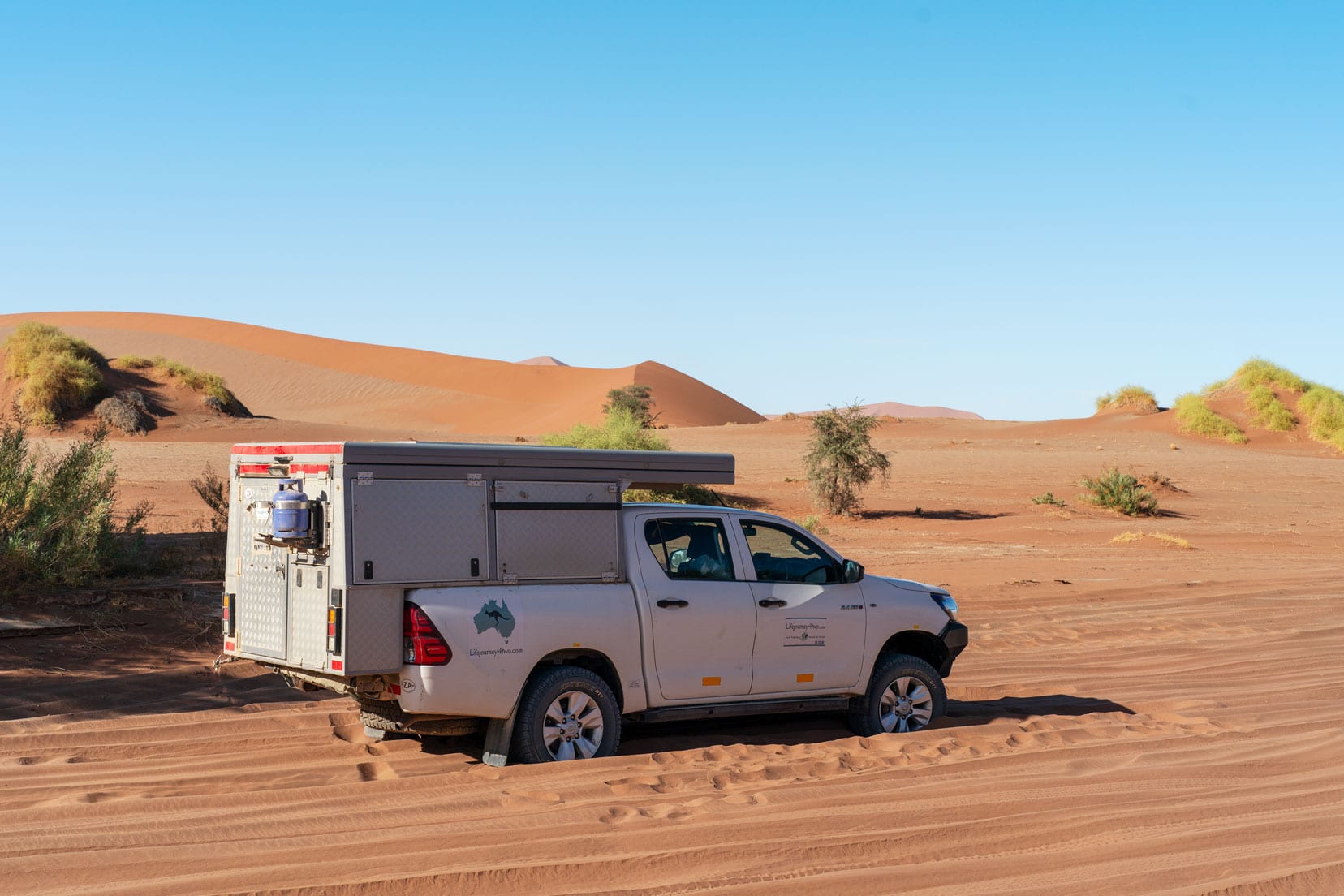
Essential Gear for Your Sossusvlei Adventure
🧣 Cooling towels: Vital for staying cool in the intense desert heat.
🔦 Safari spotlight/torch and headlamp: Navigate safely during early mornings or late evenings.
👒 Safari hat: Essential for sun protection while exploring.
🥤 Water-To-Go and Lifestraw Go filter bottle: Ensure access to safe drinking water.
🔋 Portable power bank: Keep your devices charged on your adventure.
👕 Men’s Safari Shirt and Women’s Safari Shirt Choose lightweight and breathable fabric for comfort.
👖 Men’s convertible pants and women’s convertible safari pants: Stay adaptable to changing temperatures.
👀 Vortex Optics Diamondback 10×42 Roof Prism Binocular: Get up close with distant landscapes and wildlife.
📷 Camera Gear: Don’t miss capturing the stunning dunes and desert landscapes.
🎒 Backpack: Carry all your essentials for a day trip comfortably.
For more detailed information on what to pack for a safari adventure, check out our Comprehensive Safari Accessories Guide.
Camping at Sossusvlei
The best option is to camp inside the Namib-Naukluft Reserve, and at Sesriem, there are a couple of camps and lodges inside the Reserve. Camping in Sossusvlei, 60km from Sesriem, is not permitted.
There are also campsites and lodges outside of the park. However, if you want to witness the dunes and Deadvlei at sunrise, stay inside the park. Camping inside the gate allows you to enter the park an hour before sunrise.
Departing at this time means you can arrive at Sossusvlei around sunrise.
Deadvlei and Sossusvlei are 60 kilometres from the main gate, and the speed limit on the tarred road is 60 km per hour, so it is about an hour’s drive.
The two mornings we set off from the camp, a snake of red lights travelled in front of us. I’m not sure everyone was sticking to the 60km/hour limit, though!
Watch out for animals, such as Oryx, on the road; they are often hard to see.
Sesriem Oshana Camp
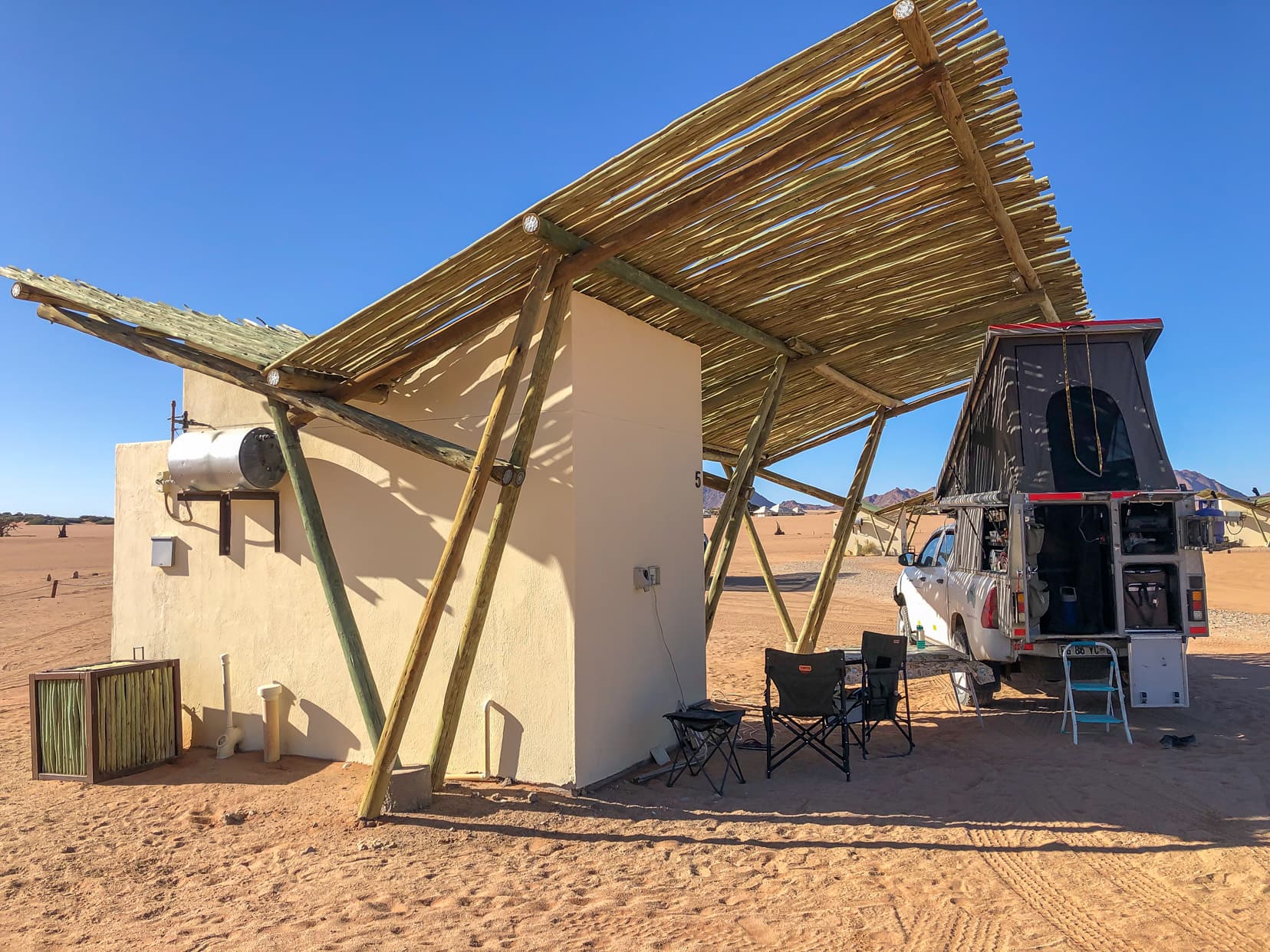
To get to Oshana Campsite, you will drive a little further (west) from the main office where you have paid your fees, and you’ll find the turning on the right for Dead Valley Lodge and Oshana Camping.
Check-in for both is at Dead Valley Lodge.
We chose to camp at a Sesriem Oshana Camp, which cost N$400 per person per night. You can book it via Sossusvlei Reservations.
Each of the ten campsites has electricity, a shaded area, shower and toilet, a metal sink for dishes, a rubbish bin and a braai.
The facilities were clean and well-maintained.
And the extra bonus?
Oshana campers can also use the swimming pool and bar area at Dead Valley Lodge. However, meals and WIFI are only available for lodge guests.
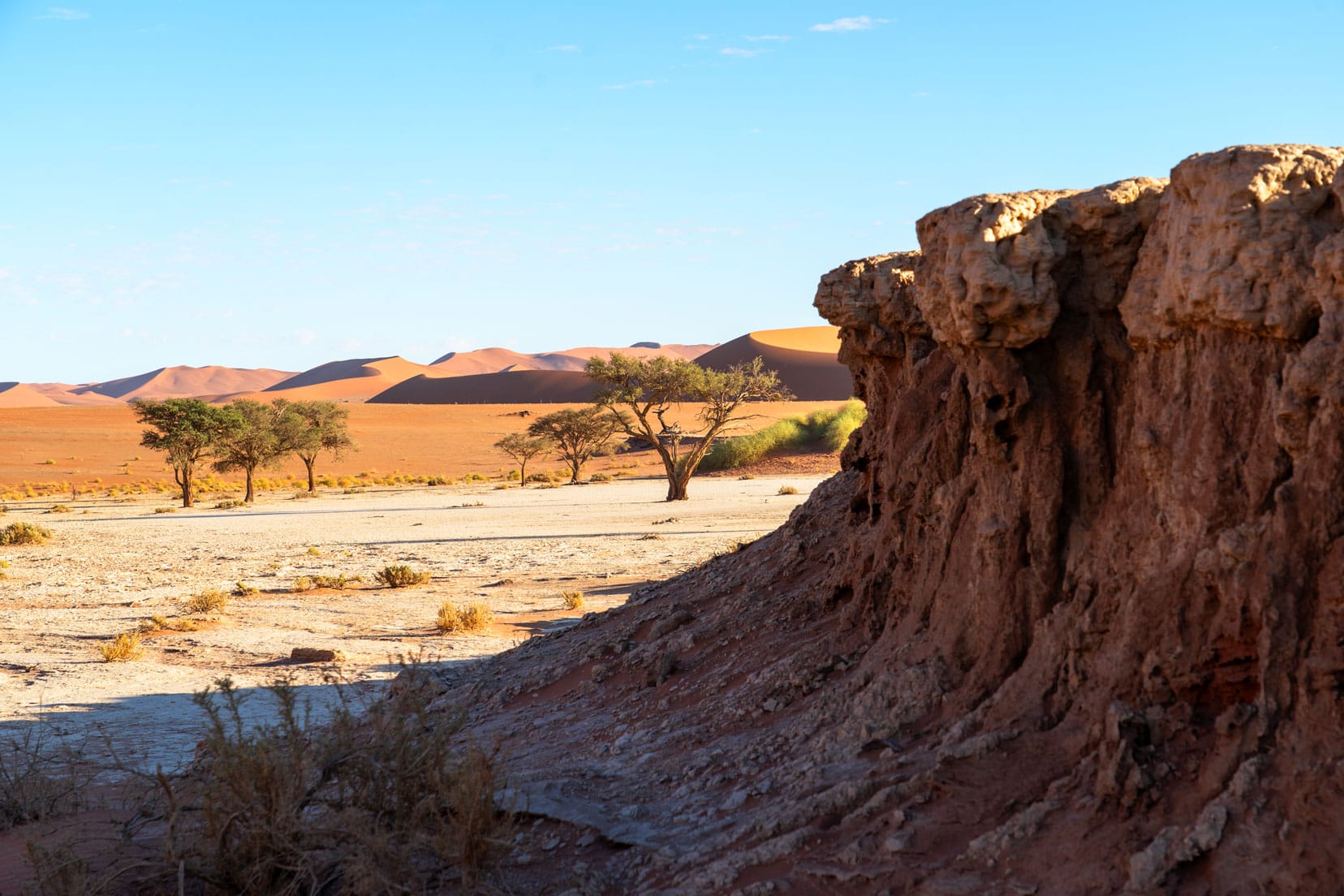
Sesriem Rest Camp
The Sesriem campsite has 44 sites with shared ablutions around camel thorn trees. Each site also has an electrical point, water tap, braai and costs about N$610 per person per night.
There is a fuel station, restaurant, bar, shop for basic supplies, and a swimming pool.
You can make reservations through NWR.
Lodges in Sossusvlei
There are two lodges within the park.
Dead Valley Lodge
Dead Valley Lodge provides 20 premium tented chalets. Each chalet has air conditioning and features a double bed, power points, a private patio, a kitchenette, and a bathroom.
Guests can use the restaurant, swimming pool and WIFI.
Sossus Dune Lodge
If you want to see the sunrise at Sossusvlei or have the opportunity to climb Big Daddy and watch the sunrise, stay at the luxury lodge, Sossus Dune Lodge. If you stay here, you can get to Big Daddy even earlier.
An Italian couple we chatted with, who were staying at this lodge, had left with a breakfast box at 5.30 am and had time to climb Big Daddy, watching the sunrise from the top. Compared to those of us from Oshana camp who arrived at Big Daddy AT sunrise.
Sossus Dune Lodge is adjacent to the Sesriem Canyon.
See their website for details.
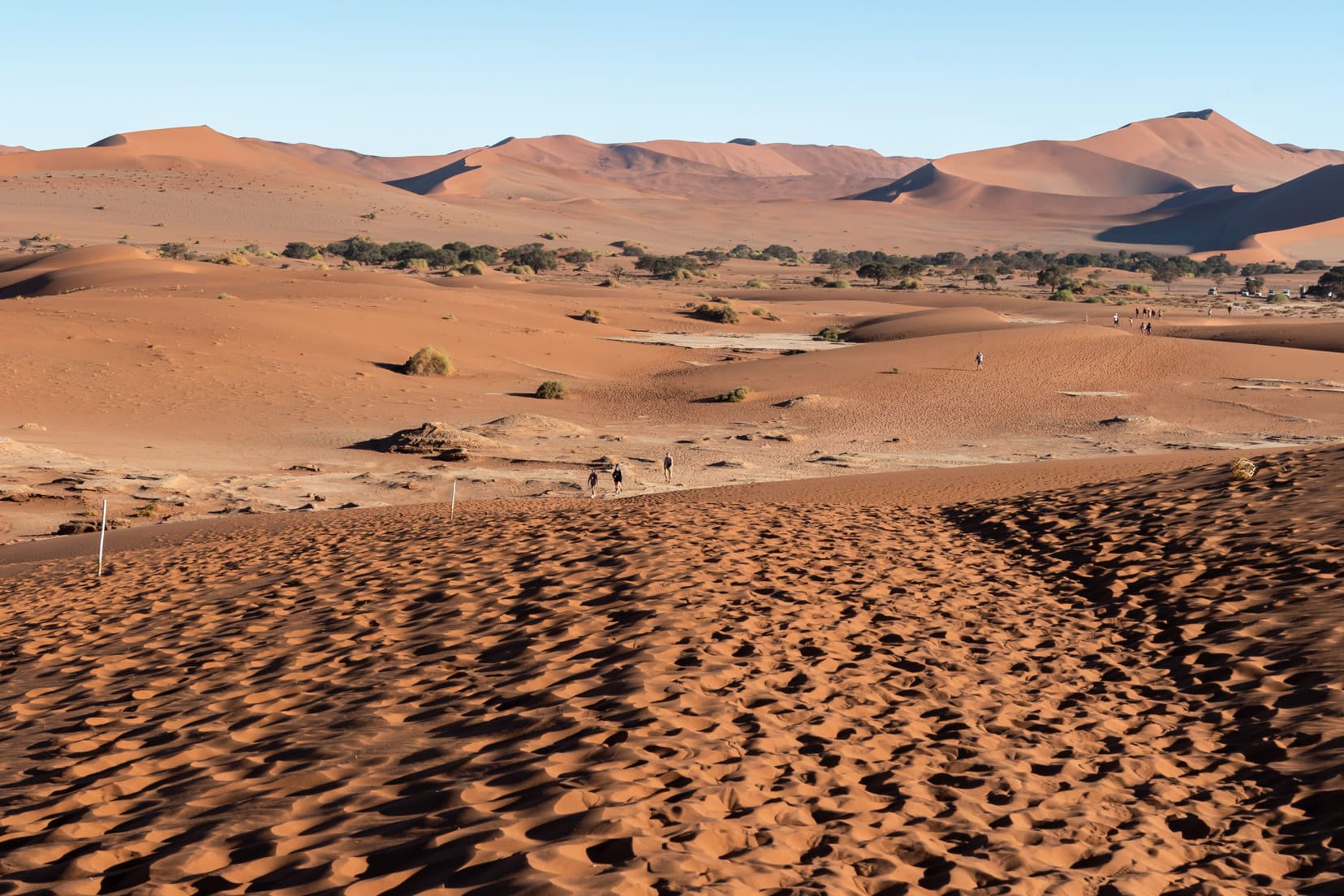
What to do at Sossusvlei
Sossusvlei is a jewel in the heart of Namibia’s Namib Desert. It offers many breathtaking activities for those of you with an adventurous spirit.
This section guides you through the must-visit spots within this spectacular landscape. From the towering heights of its famous dunes to the eerie beauty of Deadvlei.
Sossusvlei has something to enchant everyone. Whether you’re keen to test your limits by climbing the colossal dunes or prefer a serene walk amidst ancient natural wonders.
Join us as we explore Sossusvlei, its iconic Big Daddy Dune, the easily accessible Dune 45, the lesser-known but equally mesmerising Big Mama and the hauntingly beautiful Deadvlei.
Each offers a unique glimpse into the desert’s heart. Plus, we’ll touch upon Hiddenvlei, a hidden gem for those seeking a quieter experience away from the more frequented sites.
Here are the best places to visit in Sossusvlei:
Big Daddy Dune
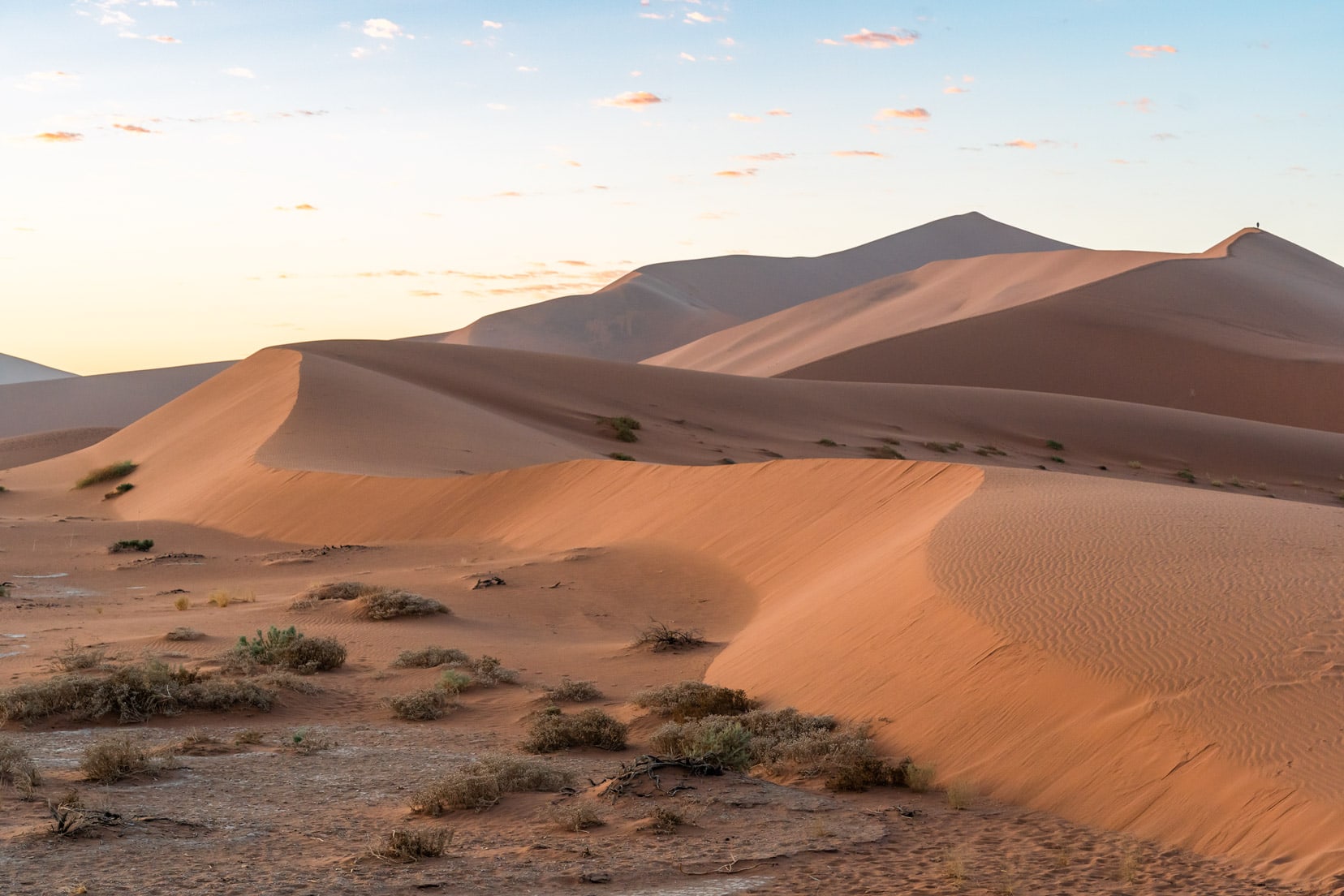
If you are driving in a 4×4, you’ll arrive in the Deadvlei parking area at the end of the sandy tracks, almost at the foot of Big Daddy.
When facing the direction of Deadvlei, the huge dune on your left is Big Daddy.
This is the highest dune in Sossusvlei, at about 325 metres tall. Though, it’s not the highest in the Namib Desert.
So what is the tallest dune, then? I hear you ask.
That accolade, coming in at a massive 388 metres, falls to Dune 7. Its unimpressive name seems rather belittling for a dune of such status, but it’s so-called because it’s the seventh dune along the Tsauchab River.
Dune 7 isn’t really a dune. It’s a dune belt with views over the Dorob National Park in the Walvis Bay Area, about 200km north of Sossusvlei.
As its name implies, Big Daddy is BIG, and climbing up this colossal icon is no mean feat. Wanting to save energy for more essential activities, like climbing into bed at night, neither of us ventured to its peak.
Instead, we took photos from below.
Big Daddy looks over the hauntingly beautiful Deadvlei, where we spent most of our time.
From here, we could be equally impressed by the antlike size of the enthusiastic and triumphant figures who defeated Big Daddy and could just be seen high-fiving and likely gasping for air at the summit.
How was the Big Daddy dune formed?
The formation of Big Daddy mirrors the same process as all the dunes in the area.
Big Daddy, the tallest dune in Sossusvlei, was formed about five million years ago, along with the other dunes in the area.
Its red sand, coloured by iron oxide, was washed from the Orange River towards the sea and then driven north by the Benguela Current to Luderitz. Inland northwest winds distributed the sand, forming the dunes.
The constantly changing shapes of these dunes, including Big Daddy, are influenced by wind patterns, creating unique parabolic or star dune formations that can extend up to 50 kilometres in width.
Sossusvlei Dune 45
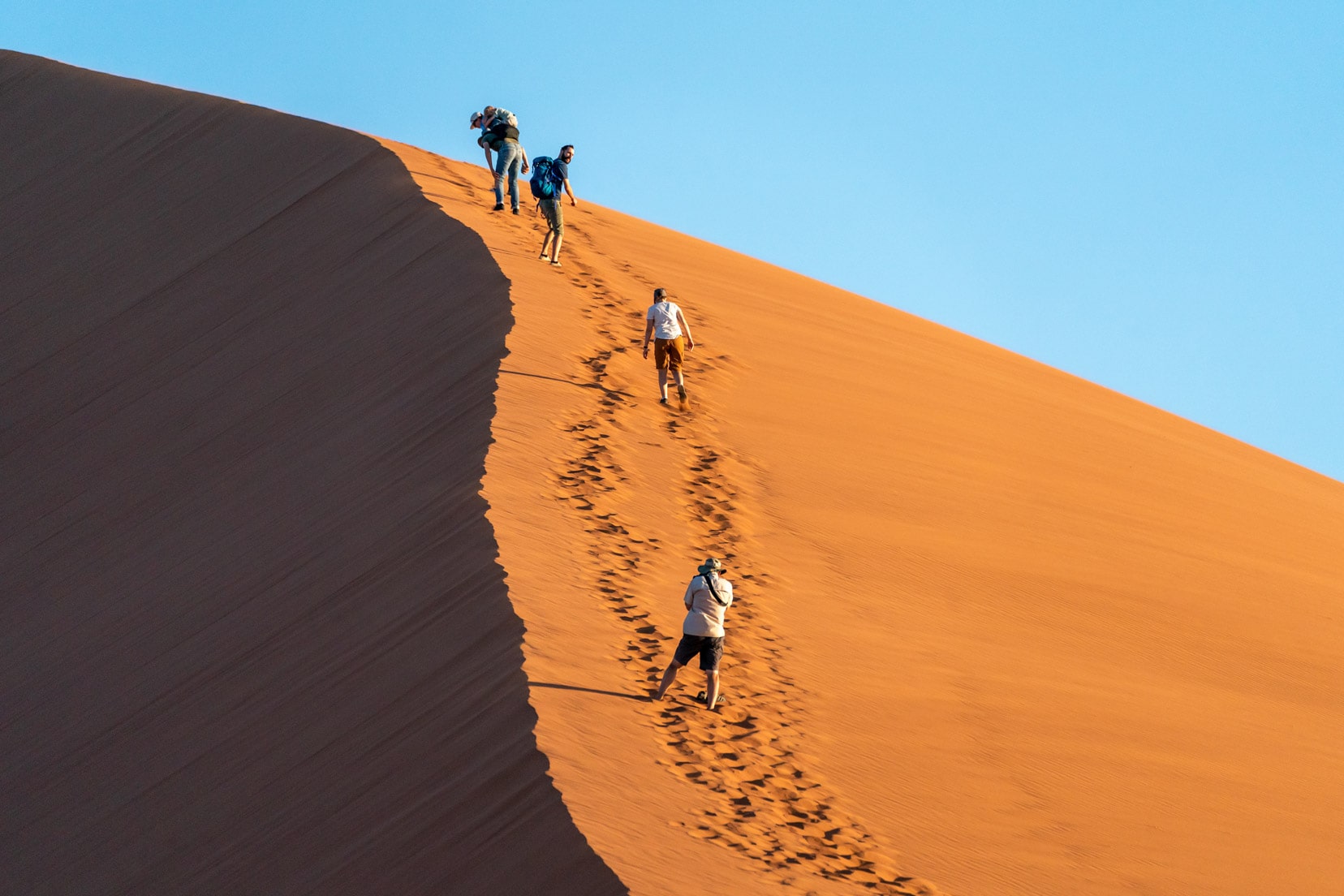
If you are wanting to climb at least one of the dunes at Sossusvlei, then Dune 45 is a good option.
It’s easier than Big Daddy because it’s about a quarter of its size and much easier to get to. It’s also a great dune to take photos of at sunset or sunrise because it is only about 45 minutes from the second entrance gate.
Surprisingly, only one of us felt the urge to conquer at least one of the Sossusvlei dunes. So, while one of us trudged up the crest of Dune 45, the other played the no less important role of capturing the moment on camera.
I’m sure the sunset was just as beautiful from where I sat in the car park to that from the top of Dune 45. And at least my calves weren’t burning!
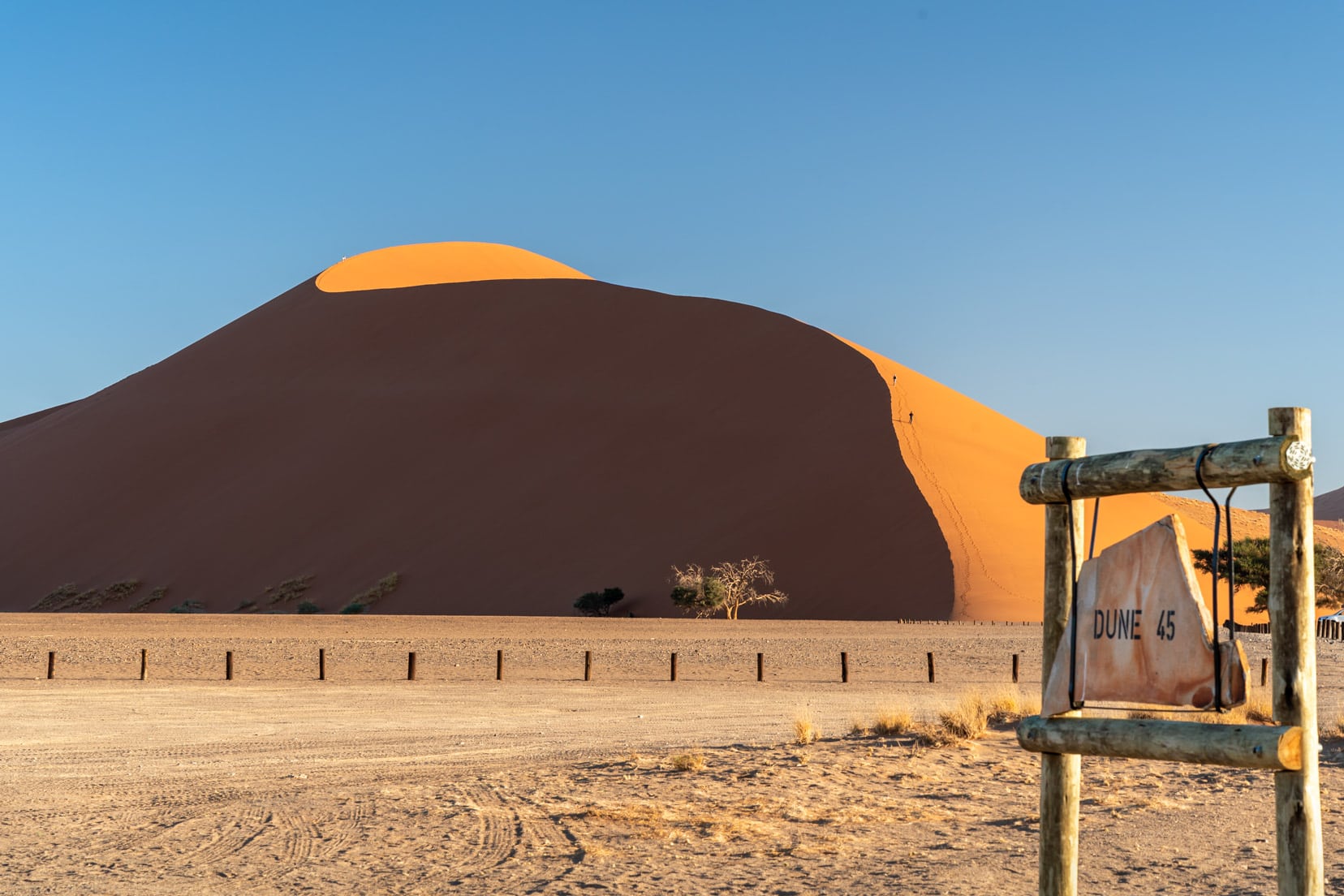
Dune 45 is 85 metres high, and from the top, you can see down into Dune Valley. It’s a great spot to watch the sunrise and sunset.
Sossusvlei Big Mama
Sitting opposite the Big Daddy dune is Big Mama. It’s not quite as popular, but it’s easier to climb. When we were there, it seemed the most attractive of the two, with a crater-like half-moon shape across its peak.
Its serene charm and softer gradients create a picturesque scene, particularly at sunrise or sunset, making it a delightful alternative for those exploring the diverse landscape of Sossusvlei.
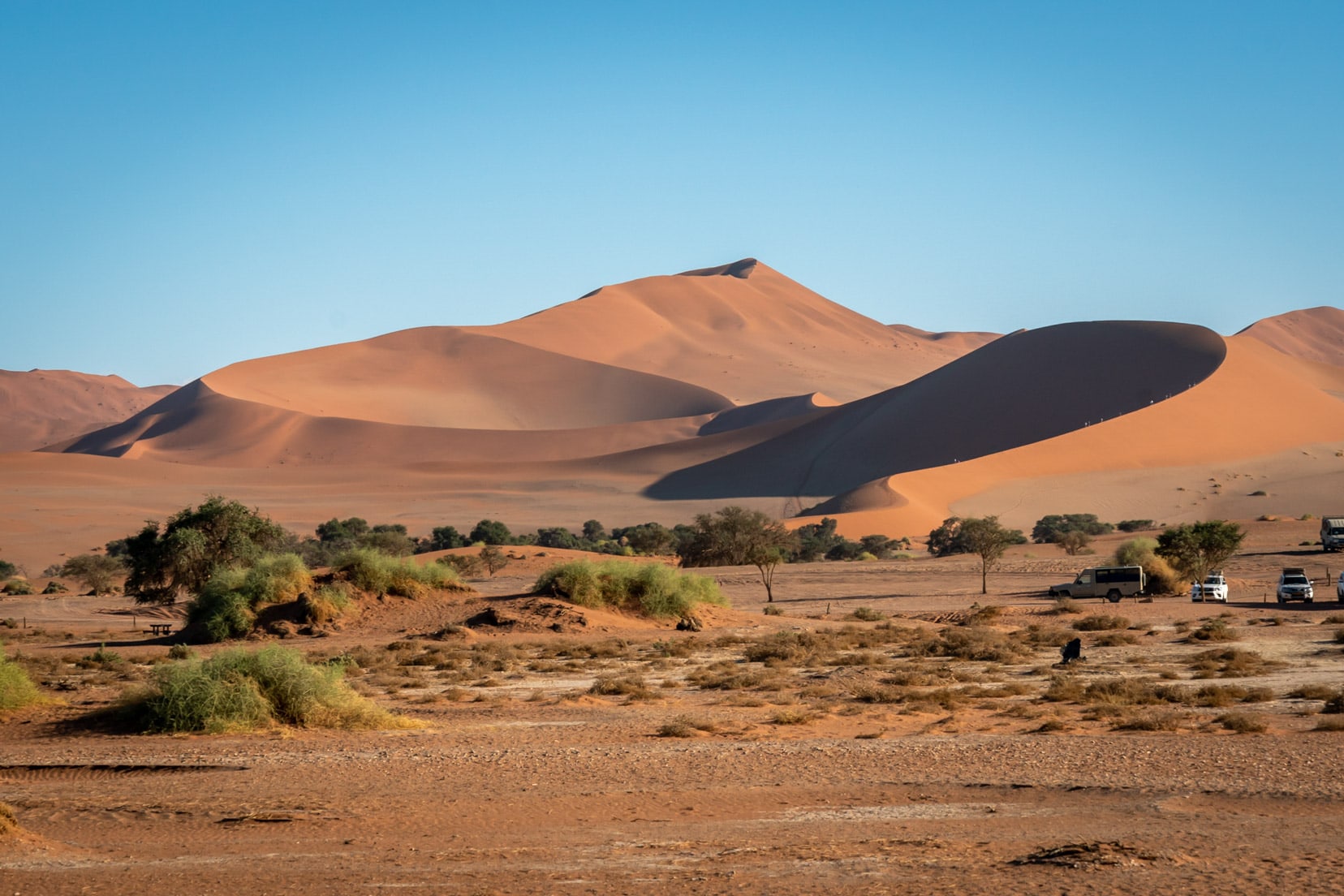
Deadvlei
Nestled in the shadow of Big Daddy lies Deadvlei. Dead Vlei means Dead Lake.
This iconic clay pan is known for its surreal landscape, featuring lifeless camel thorn trees over 900 years old. Once thriving and green, these trees now stand scorched black and motionless, preserved by the arid desert conditions.
They create a stark contrast against the white clay pan, casting eerie shadows across the red sand.
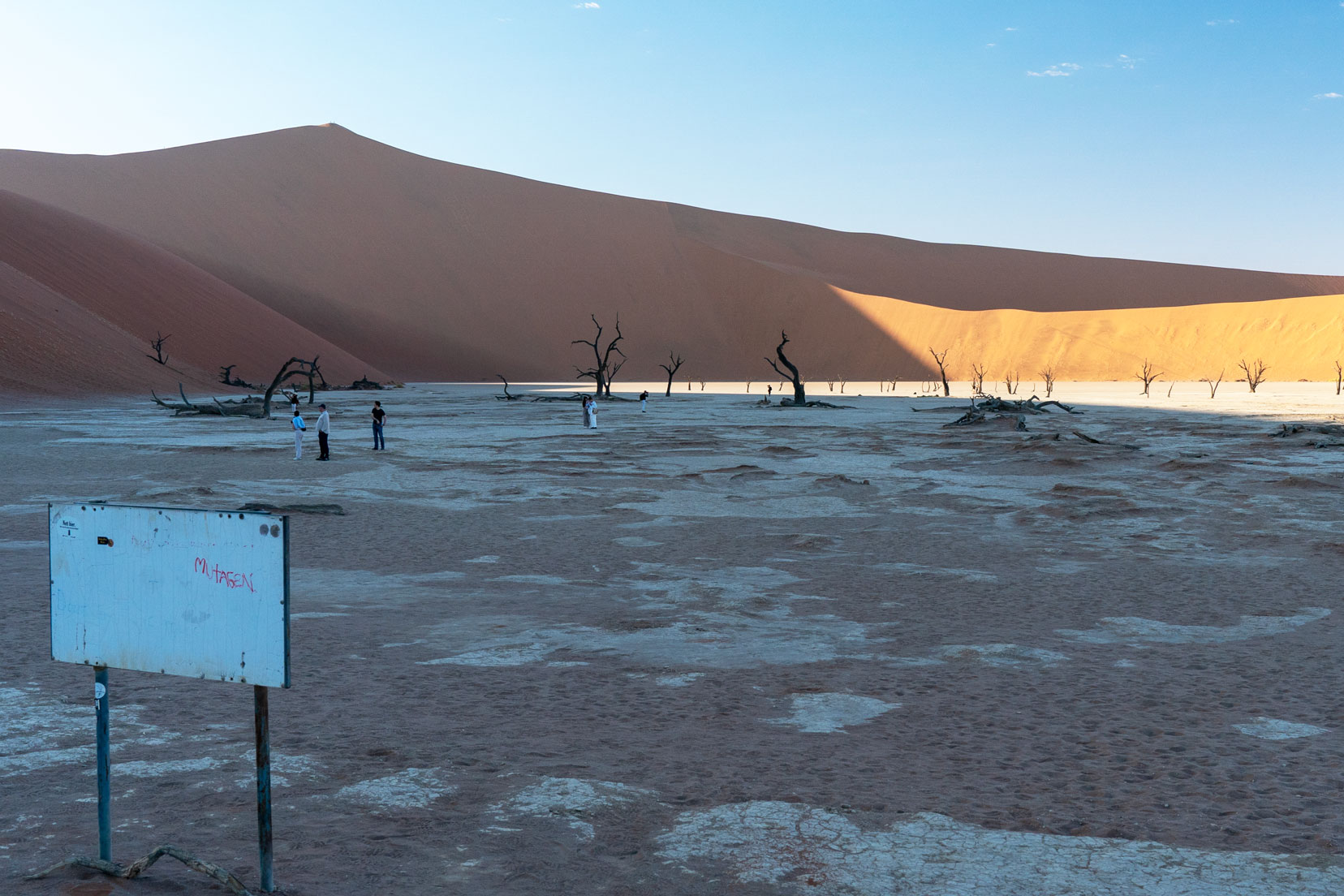
Deadvlei’s formation dates back to a time when the Tsauchab River flooded, allowing camel thorn trees to flourish. However, as the climate shifted towards drought, sands engulfed the area, cutting off the water supply and leading to the trees’ demise.
Today, their hauntingly beautiful skeletons remain, drawing artists and photographers from around the world to capture this unique and captivating scene.
A visit to Deadvlei involves about a kilometre’s walk from the car park, but the journey unveils a landscape frozen in time, offering an unforgettable glimpse into the heart of the Namib Desert.
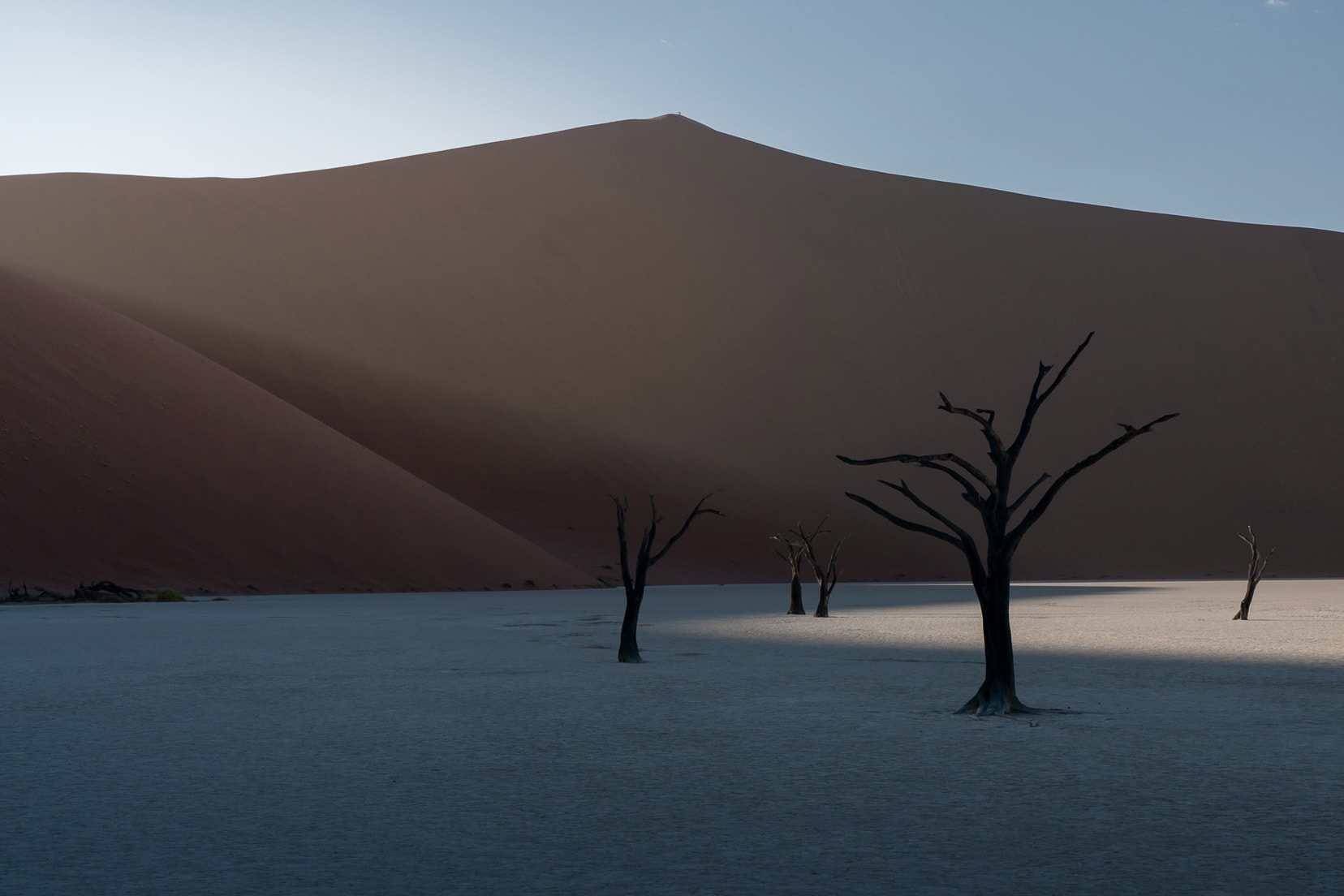
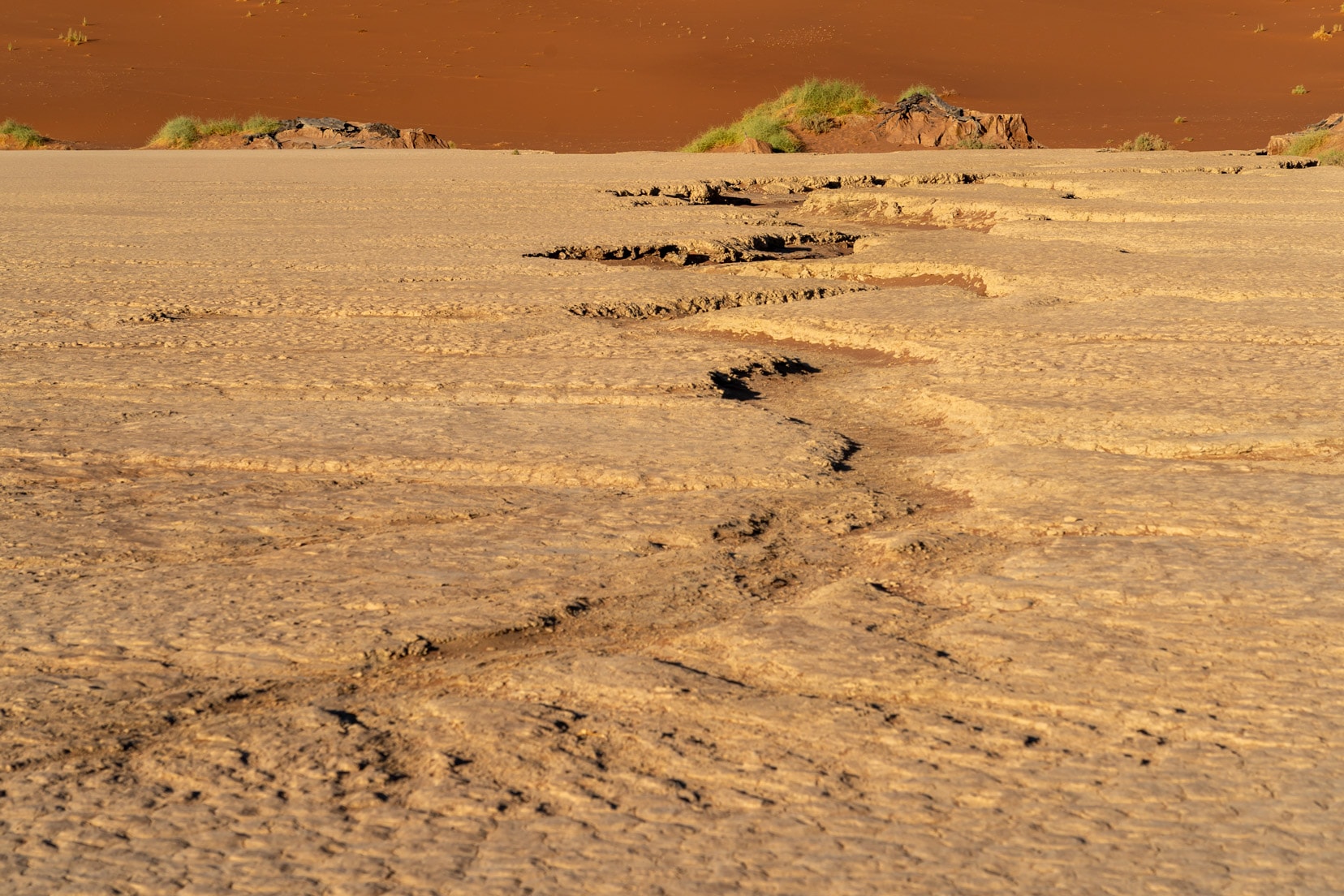
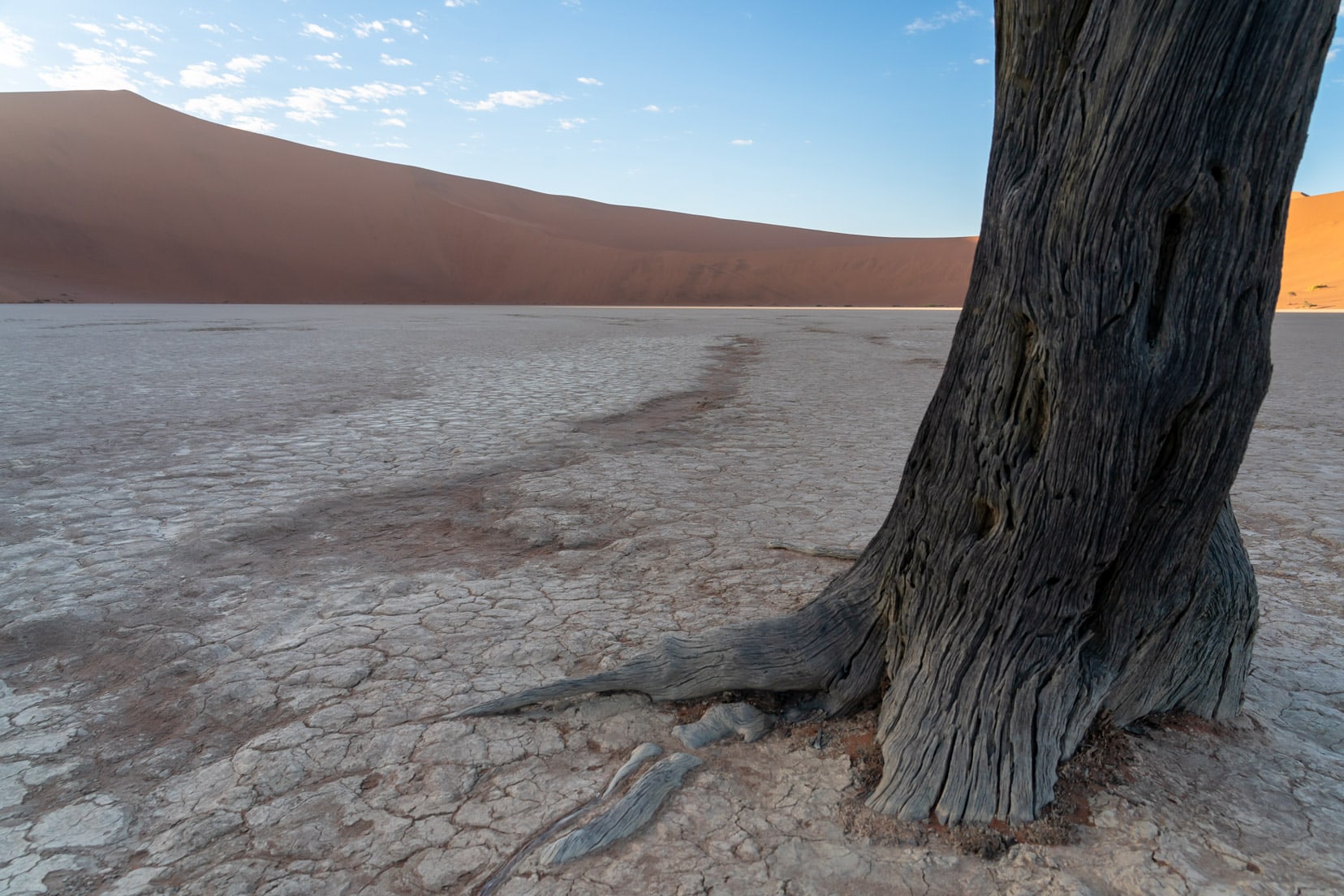
Hiddenvlei
Wooden poles mark the trail to Hiddenvlei from the 2×4 carpark (where you park if you haven’t got a 4×4 or want to pick up the shuttle to Sossusvlei). It’s about a 2-kilometre hike from here.
We didn’t do this hike because the temperature was rising and too hot by the time we had finished visiting Deadvlei.
If you are visiting in cooler weather and have time, a couple of German tourists told us it was worth visiting. They said it was less dramatic than Deadvlei but had fewer tourists, so they thought it was more enjoyable.
Elim Dune
Elim Dune, a smaller yet captivating sand hill in Sossusvlei, offers visitors an easily accessible experience of the dunes.
It’s located near Sesriem Campsite, making it one of the first dunes you see when entering the park. Known for its relatively easy climb and spectacular views of the desert landscape, Elim Dune is perfect for those seeking a quick yet rewarding dune adventure.
Its position provides stunning views of the Naukluft Mountains and the vast desert expanse, making it a popular spot for sunset watchers. Photographers are drawn to its serene beauty and how it captures the changing desert light.

Sossusvlei Fairy Circles
We saw mention of Fairy Circles on the map, so we set off to find them. You can see them faintly from the road – and honestly, that’s the best location to see them.
We did park up and walk across the sand, but when up close, it was much harder to make them out.
They weren’t as pronounced as the photo we found on the website Science Friday that discusses these phenomena.
Fairy circles have long sparked curiosity in the Namib Desert’s Sossusvlei area. Local legends attribute these mysterious barren patches, encircled by grass, to gods leaving their footprints. However, science offers two main explanations:
- Plant Competition: Scarce water resources lead to intense competition among plants. The stronger vegetation absorbs moisture, leaving dry patches that form these circles.
- Termite Activity: Each circle is linked to an underground termite colony. The termites’ foraging patterns disrupt vegetation, contributing to the circular shape.
Though folklore adds a mystical aspect, the combination of plant competition and termite activity provides a more scientific understanding of these enigmatic formations in the Namib Desert.
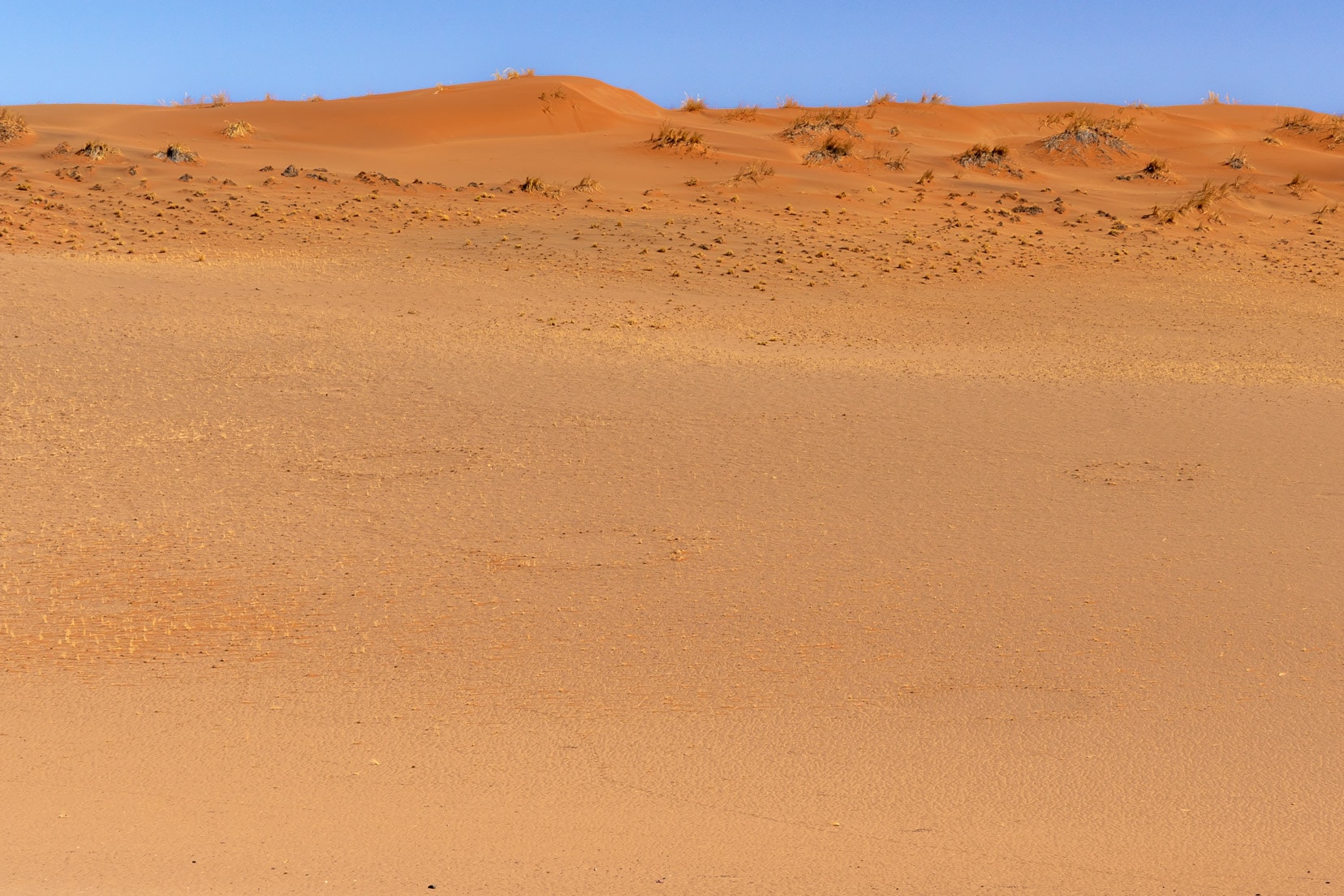
Tips For Visiting Sossusvlei
Accommodation Booking:
- Book in Advance: Secure accommodations well ahead of time, particularly if you’re aiming to stay inside the park.
Photography Preparation:
- Bring a Camera: Capture Sossusvlei’s breathtaking landscapes and diverse wildlife with a good camera.
- Best Light: Prepare for pre-sunrise wake-ups, as the light changes rapidly from soft to harsh, making early morning the best time to shoot. Evening skies can be quite spectacular, but you’ll not have much opportunity as you must be out of the park, at the latest, one hour after sunset.
- Photography Gear Guide: Check out our comprehensive guide on travel photography gear to ensure you have all the essential equipment for the perfect shot.
Looking to enhance your photography skills further?
Our detailed Safari Photography Tips and Road Trip Photography guides offer great insights into capturing stunning landscapes and wildlife.
Timing Your Visit:
- Dune Climbing: Plan to climb the dunes during the cooler hours of early morning or evening, as temperatures rise quickly once the sun is up.
- Temperature Awareness: The hottest months are October to March, with temperatures in the mid to high 30s°C. Cooler temperatures, in the mid to high 20s°C, can be expected in June and July.
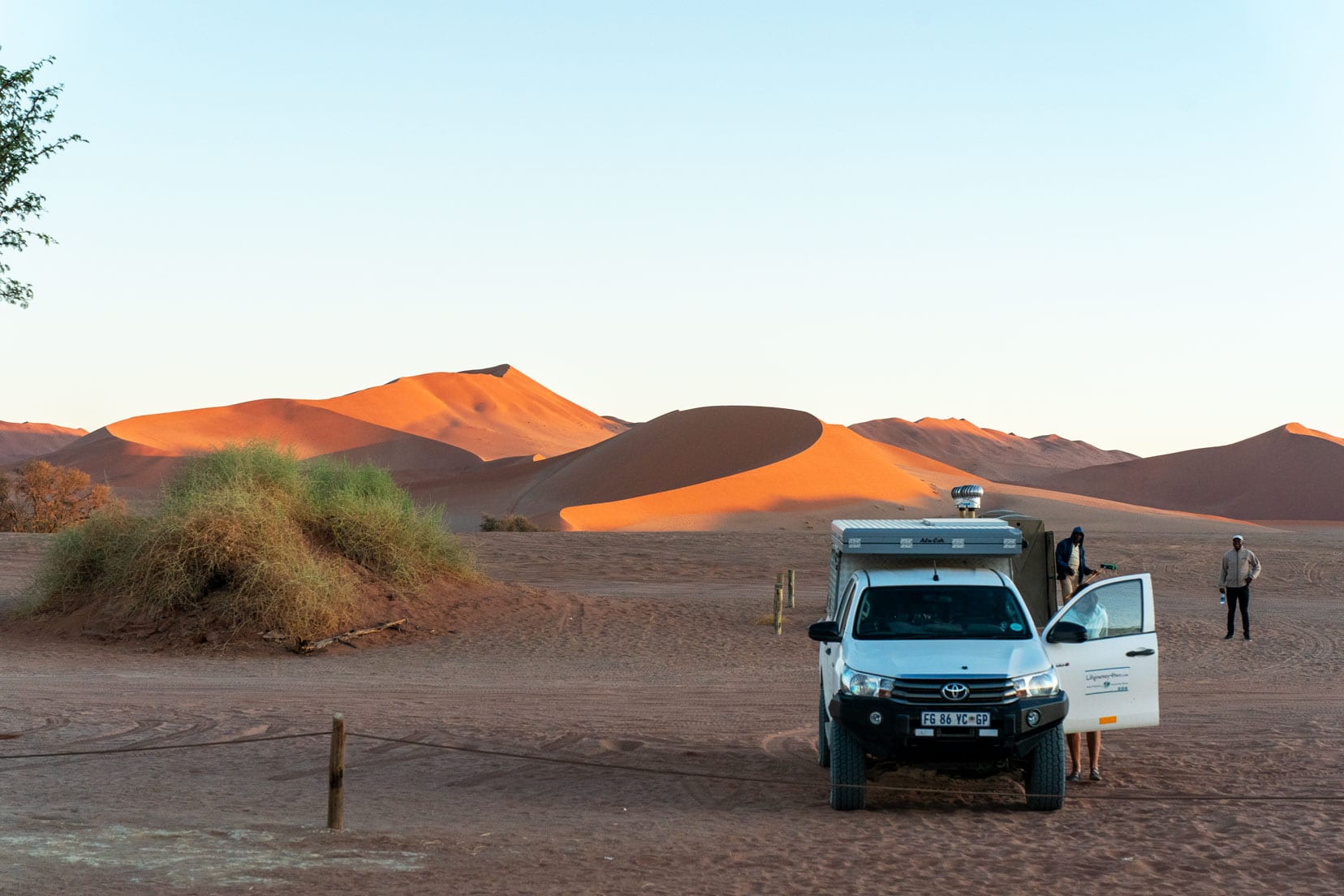
Weather and Physical Preparedness:
- Anticipate Wind: Prepare for the wind, especially in the afternoons.
- Physical Fitness for Dune Climbing: Be ready for a physical challenge when climbing the dunes. Be prepared for calf burn as you climb the high sand dunes.
Hydration is Key:
- Carry Sufficient Water: Always have enough water to stay hydrated in the desert heat, especially when exploring or climbing dunes.
Sun Protection:
- Essential Sun Gear: Don’t forget to bring sun hats, sunglasses, and sunscreen to protect against the harsh desert sun.
Footwear Recommendations:
- Appropriate Shoes: Wear sturdy shoes or sandals for walking on hot sand and climbing dunes.
Discover Unique Features:
- Look for Petrified Dunes: Keep an eye out for the ancient petrified dunes, which have solidified into rock over a billion years.
Culinary Stop:
- Visit Solitaire: When arriving or departing Sesriem on your journey, make a point to stop at the tiny outpost of Solitaire, known for its famous bakery and much-touted apple pie.
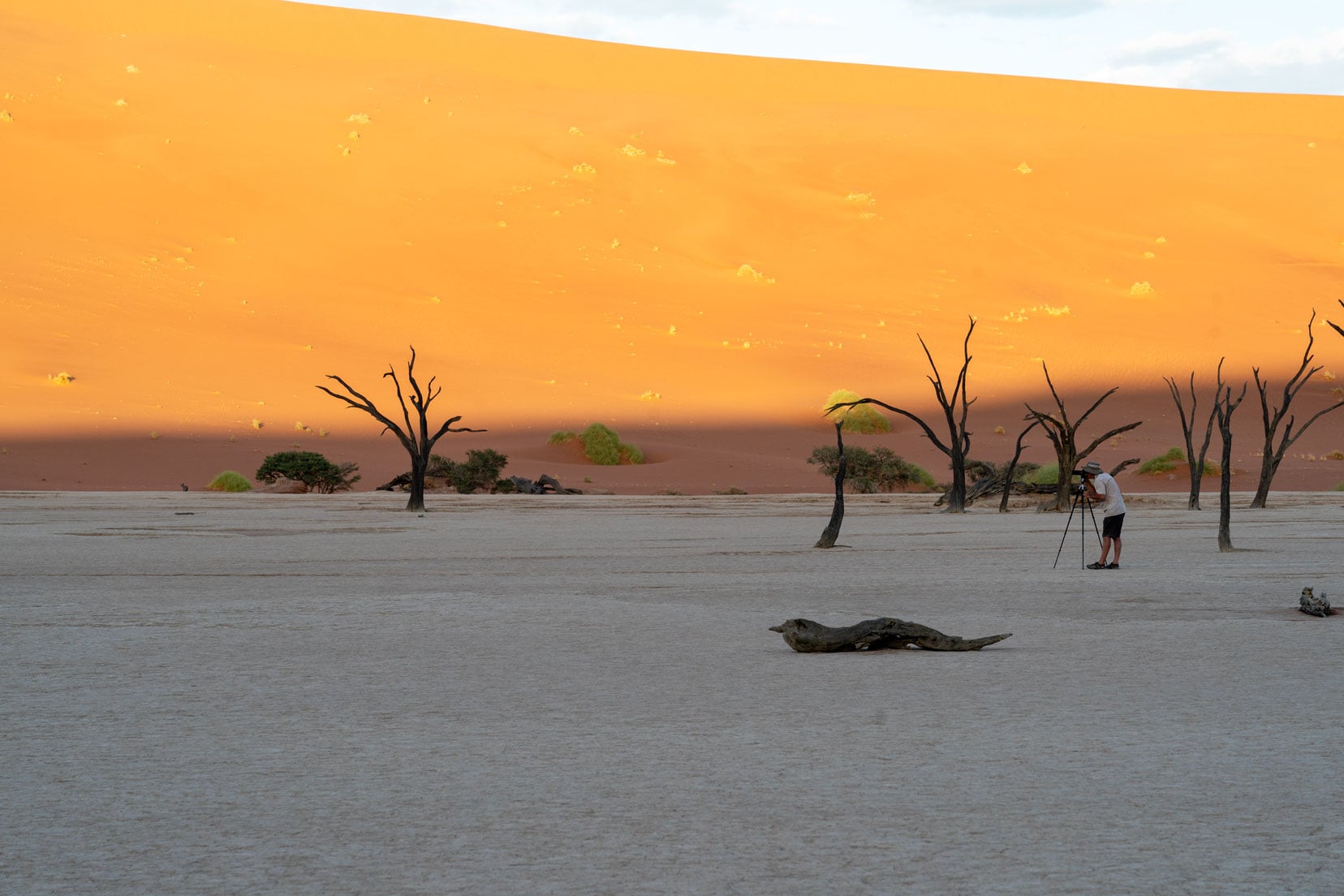
Wildlife You Might See at Sossusvlei
Sossusvlei’s wildlife is uniquely adapted to the extreme conditions of the Namib Desert.
Some interesting animals live in the area:
- Oryx (Gemsbok): These are common in the dunes around Sossusvlei. Oryx are particularly adapted to this environment as they can withstand high temperatures and survive without water for extended periods due to their low metabolism.
- Springbok: These antelopes are well-adapted to the desert environment and are found in large numbers in the region.
- Ostriches: Ostriches are commonly seen in the area.
- Small Mammals and Predators: At night, you may spot smaller mammals like the bat-eared fox, black-backed jackal, porcupine, Cape fox, and aardwolf, as well as larger predators like the spotted and brown hyena.
- Reptiles and Insects: The desert floor is home to microorganisms, beetles, spiders, reptiles like geckos and chameleons, and snakes. We went on a fantastic Living Desert Tour in Swakopmund, where we saw many of these creatures and learned about their incredible adaptations.
- Peringuey’s Adder (Sidewinding Adder): This snake, which prefers to doze in the sand during the day and hunts at night, is also present in the region.
- Birds: The area’s flora, particularly the camel thorn trees, provide a habitat for many birds like weaver birds, which build elaborate nests in these trees.
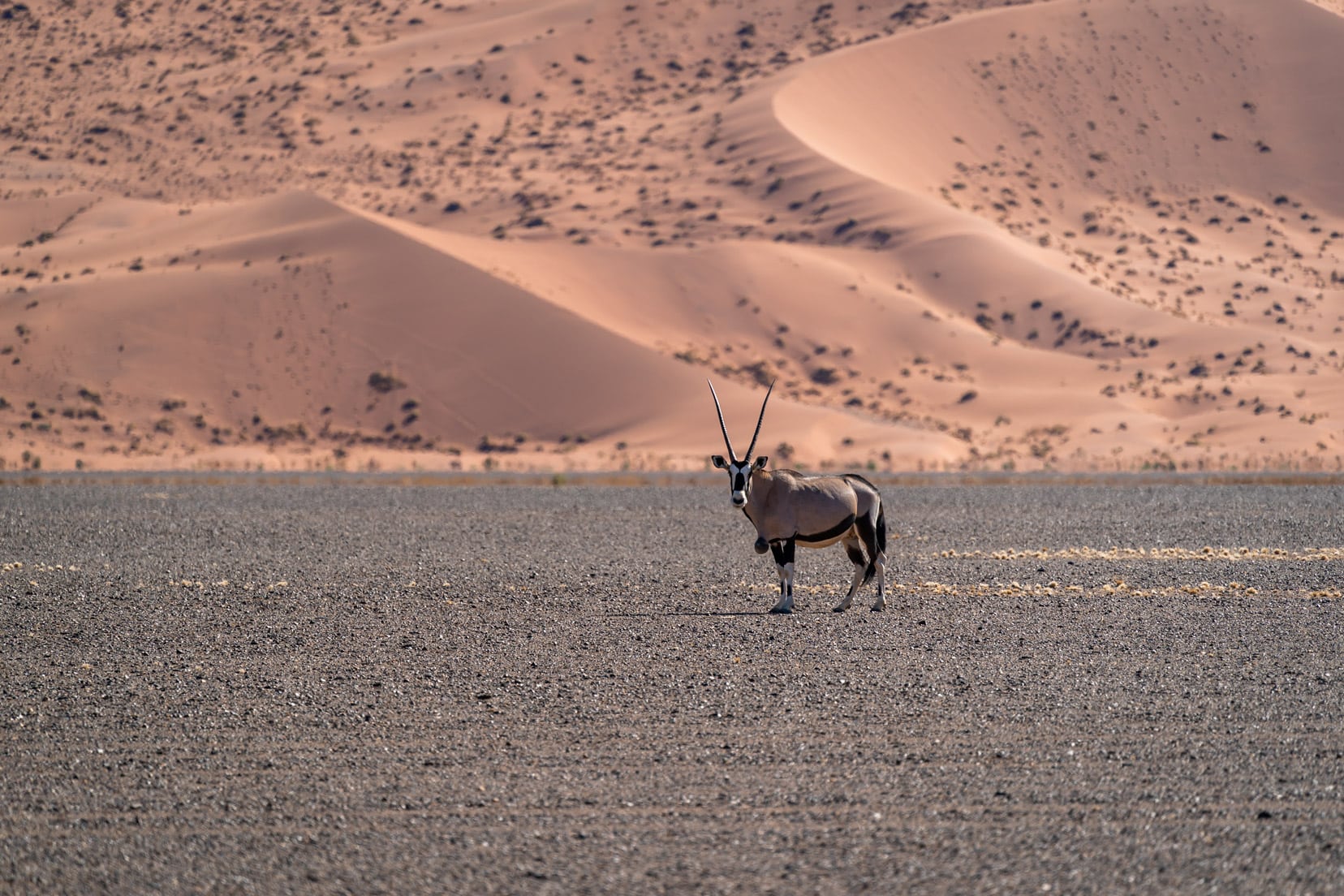
Exploring Sossusvlei is an unforgettable experience, yet there’s more to Namibia’s desert ecosystem.
Far north of Sossusvlei, the remarkable desert-adapted elephants roam in the Damaraland and Kunene regions. These giants have evolved to survive in harsh desert conditions, much like the wildlife of Sossusvlei.
Their ability to navigate and thrive in such an environment is truly extraordinary. For an adventurous journey into their world, our guide to finding these incredible desert elephants is a must-read for every nature enthusiast.
How to Visit Sesriem Canyon
Sesriem Canyon is a spectacular natural gorge just 7km (4.5 miles) from the Sossusvlei park entrance.
Formed over millions of years by the Tsauchab River, the canyon stretches for about one kilometre, with some sections reaching depths of over 30 meters and as narrow as 2 meters at certain points.
You can explore the canyon by hiking down into it. The trek reveals impressive rock formations and a tranquil atmosphere, starkly contrasting the vast desert landscapes of Sossusvlei. Often, a dry canyon floor allows for an easy walk along the riverbed, flanked by towering rock walls.
💡 Tip for Visitors: Be sure to carry plenty of water and wear comfortable shoes suitable for uneven terrain. The temperatures in the canyon can rise significantly, especially during midday.
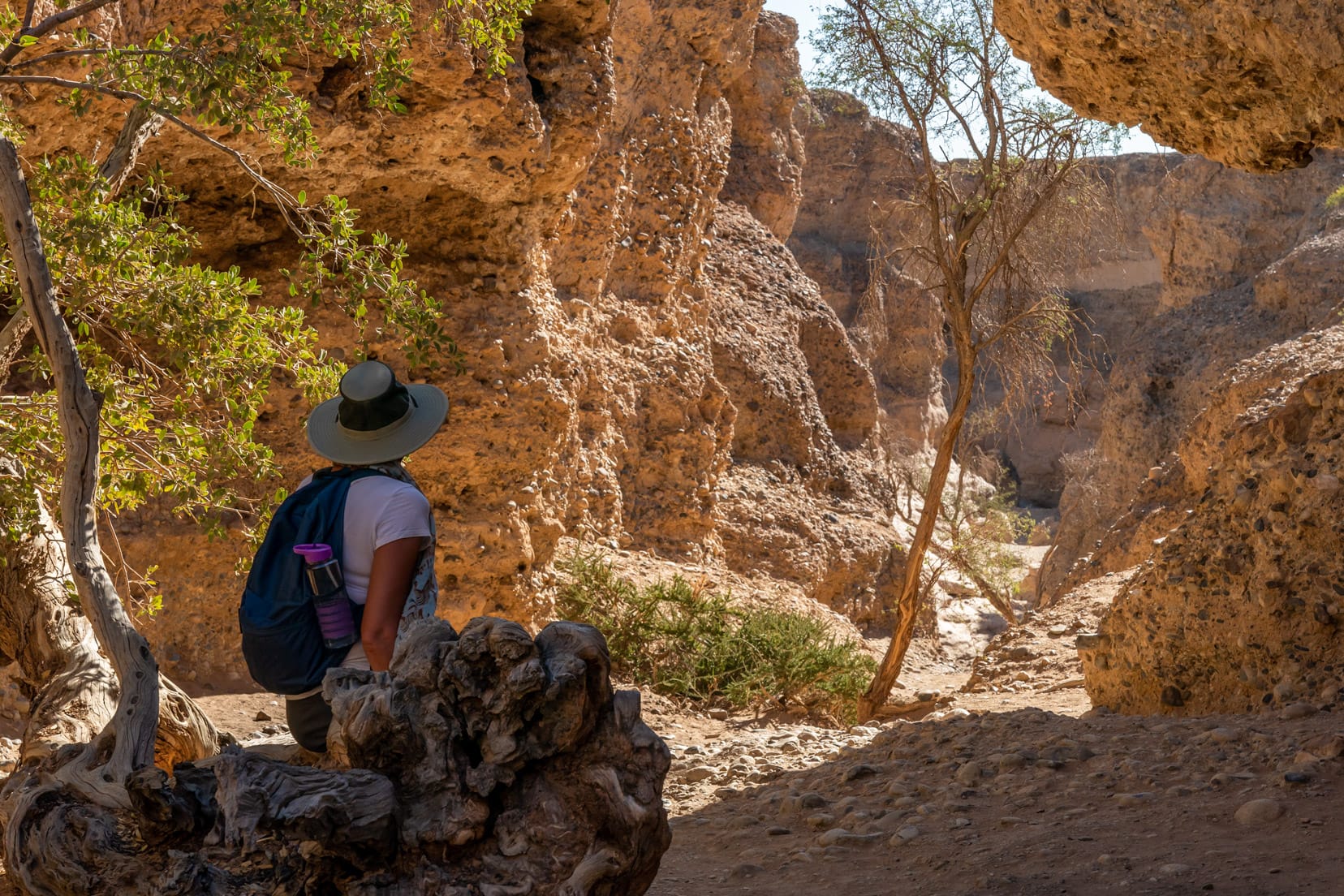
What is Sossusvlei?
Sossusvlei is one of the most visited areas of Namibia.
The attraction?
It’s a sea of photogenic sand dunes, some of the tallest dunes in the world.
Sossusvlei dunes in the Namib-Naukluft Park, otherwise known as the Sea of Sand, were World Heritage listed by UNESCO in 2013.
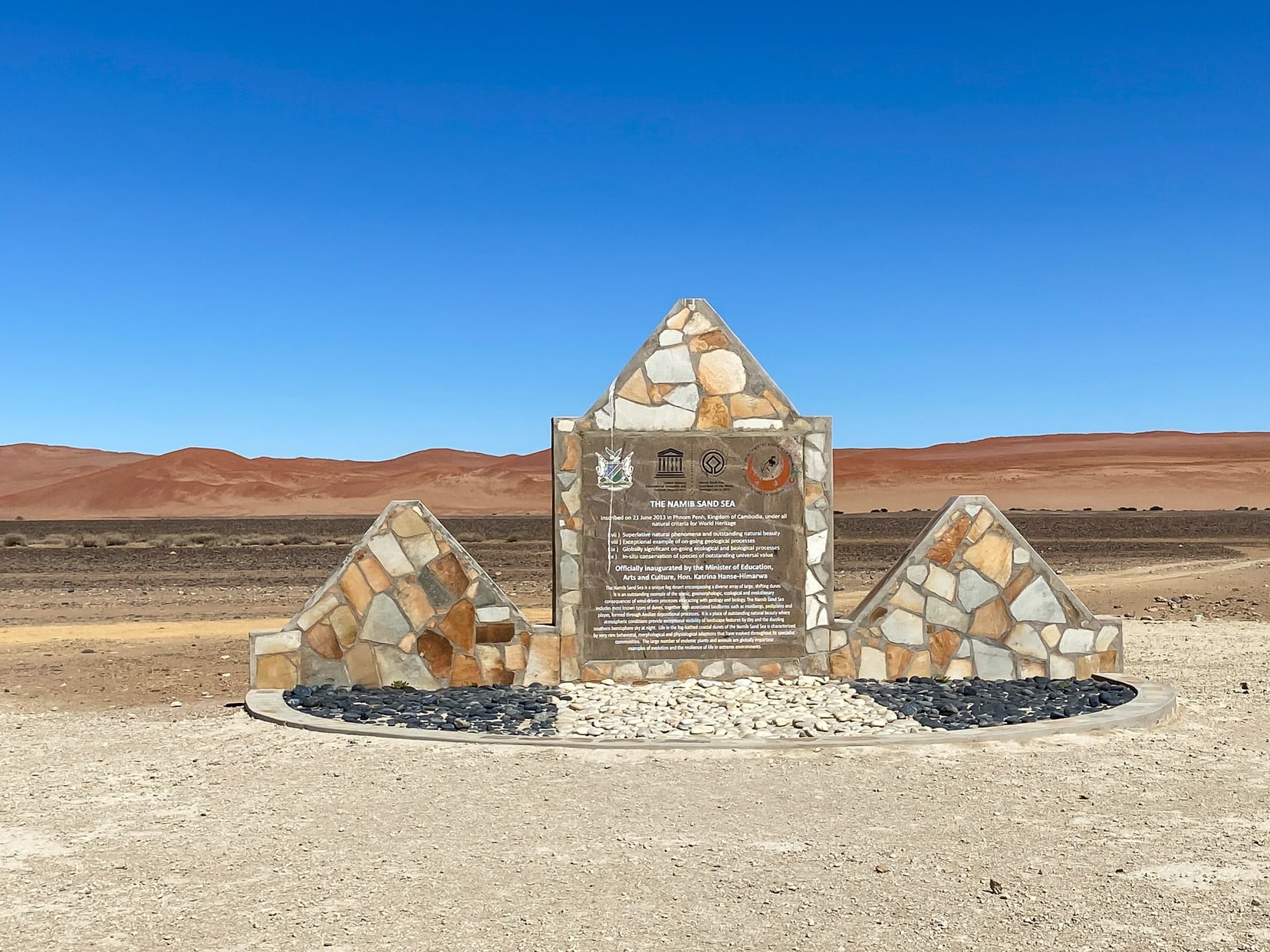
Sossusvlei has some of the world’s largest sand dunes, and the deep reddish-orange hues of towering, rippled sand are beguiling, to say the least.
Iron content in sand oxidises over time to become the coppery red that embodies Sossusvlei. These intense colours have formed over 5 million years.
The dune’s autumnal tones change throughout the day depending on the light intensity, making for great photographic opportunities.
Due to the ever-changing prevailing winds, you’ll see all sorts of shapes, some almost star-shaped. Sossusvlei dunes are called star dunes because of this.
Interestingly, although Sossusvlei has become synonymous with the huge red sand dunes, the actual Sossusvlei is a large dry salt pan.
But it’s the dunes, the undulating mountains of golden desert sand, that draw the crowds here.
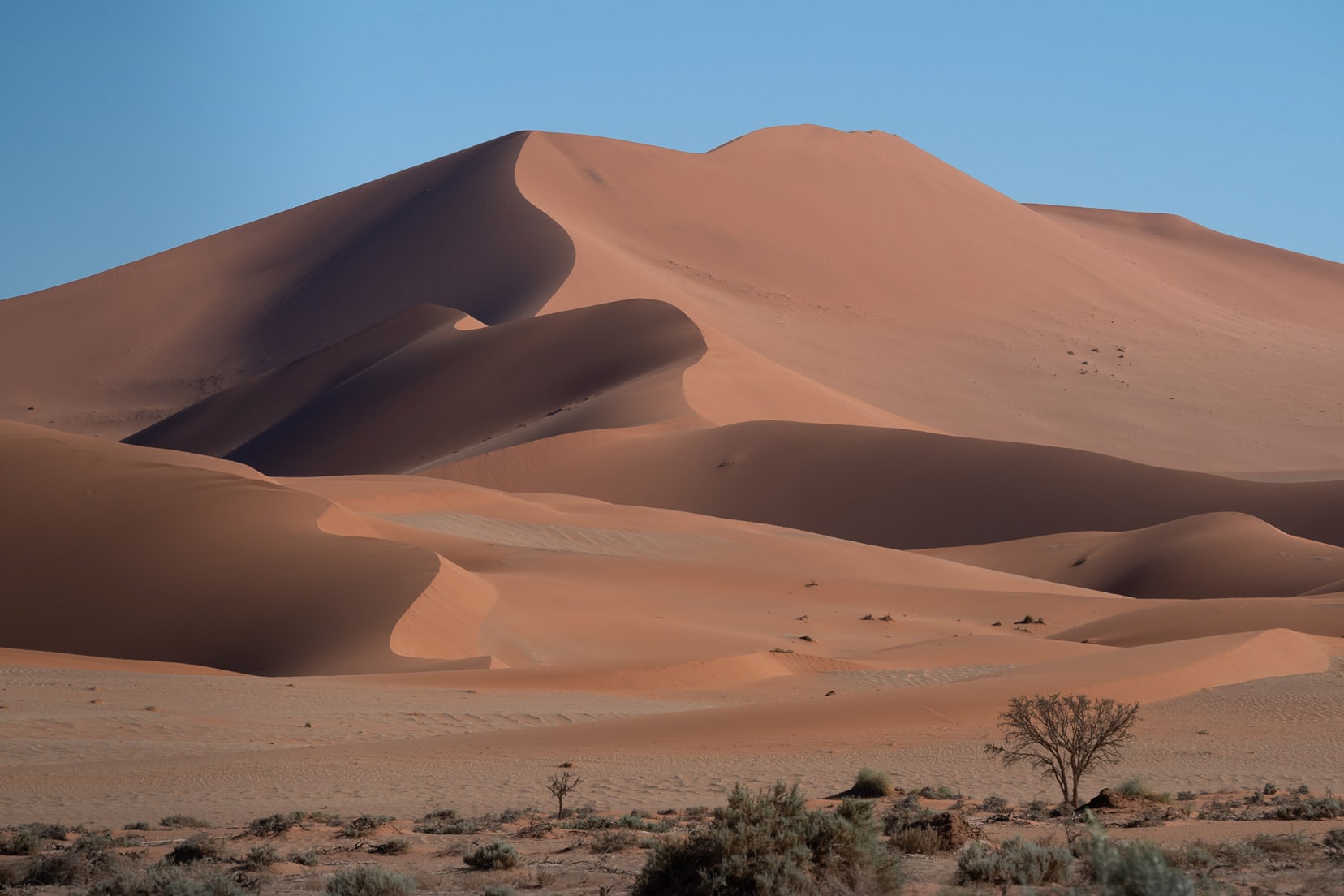
About the Namib Naukluft Park
Sossusvlei sits in the heart of the Namib-Naukluft Park in southwestern Namibia. Namib Park’s almost 50,000 square kilometres stretch from Luderitz in the south to Swakopmund in the north.
Not only is the Namib-Naukluft Africa’s fourth largest park, but it is also one of the world’s oldest deserts. Namib means open space in the indigenous Nama language, and when you visit, you will see why this landscape owns the name.
Diamonds were discovered in the area in 1908, so some parts of the park are restricted zones. This is the case, particularly around Luderitz, where you will see no entry signs dotted alongside the section of the B4 that borders the Namib-Naukluft Park.
You’ll also find the abandoned ghost town of Kolmanskop, once a thriving diamond mining town.
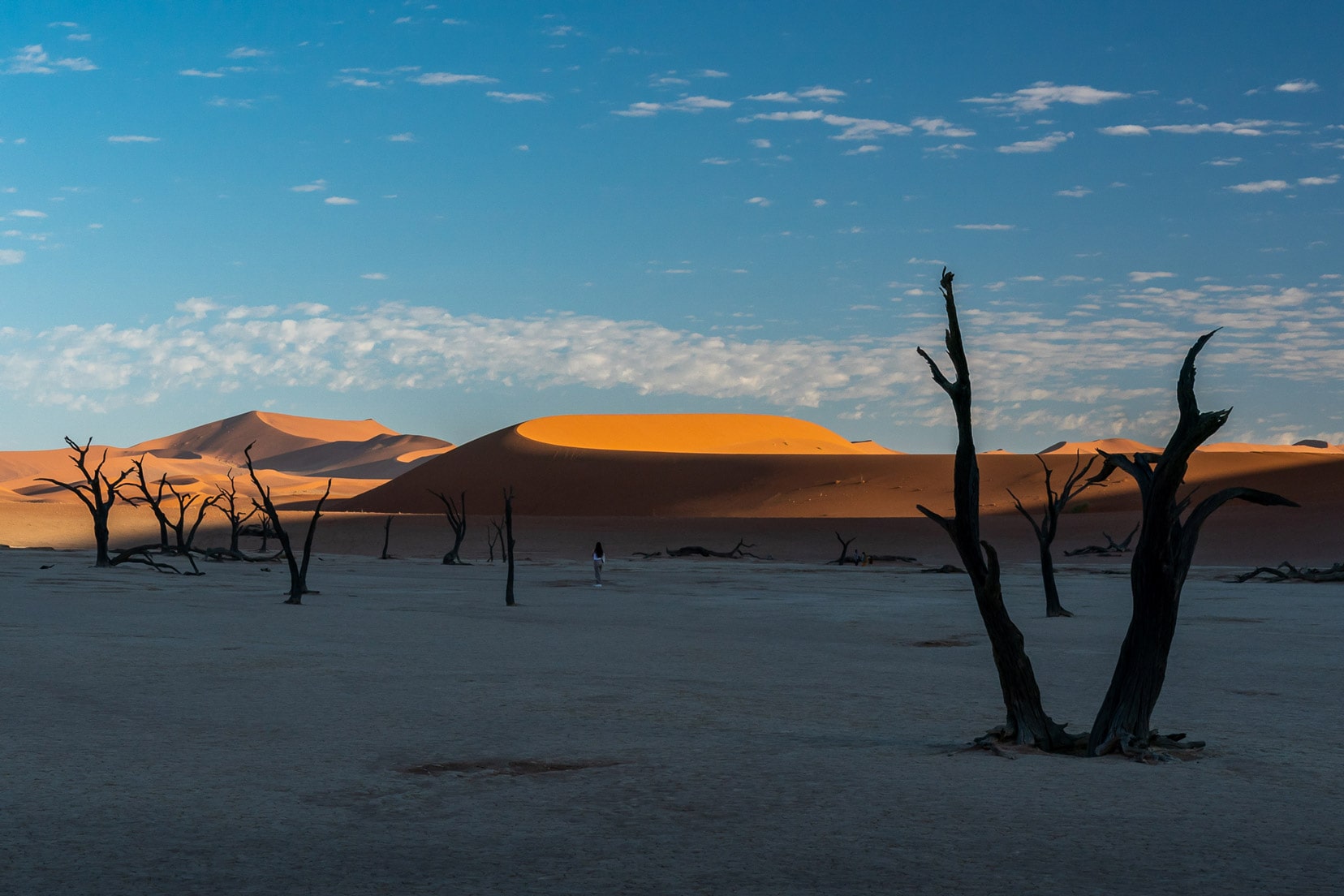
Is Sossusvlei Worth Visiting? My Take
Can I be honest with you?
I was hesitant about whether visiting Sossusvlei would live up to its hype. We have plenty of sand dunes in Australia, so I thought that our upcoming visit to Sossusvlei might have turned out to be a tad lacklustre.
I’d seen heaps of photos in magazines and on social media. But I’ve been disappointed more than once, arriving somewhere that looks so cool in the photos but is very different in reality. In fact, you wonder whether you are in the right place at all!
Does this sound familiar?
Anyway, after driving through the unfenced wilds of Botswana, with wildlife encounters galore, driving in Namibia seemed to be … dare I say it?
Boring. An endless foray of red sand and desert.
Part of its charm to many, but again … we’re from Western Australia, where red sand deserts abound.
Sossusvlei was on Lars’s bucket list, but to be frank, I would have happily driven on by, keen to reach Northern Namibia where more of the ‘wild things are’. I’d hinted as much and might have even muttered something about wasting time looking at just sand.
But don’t you hate it when you’re wrong?
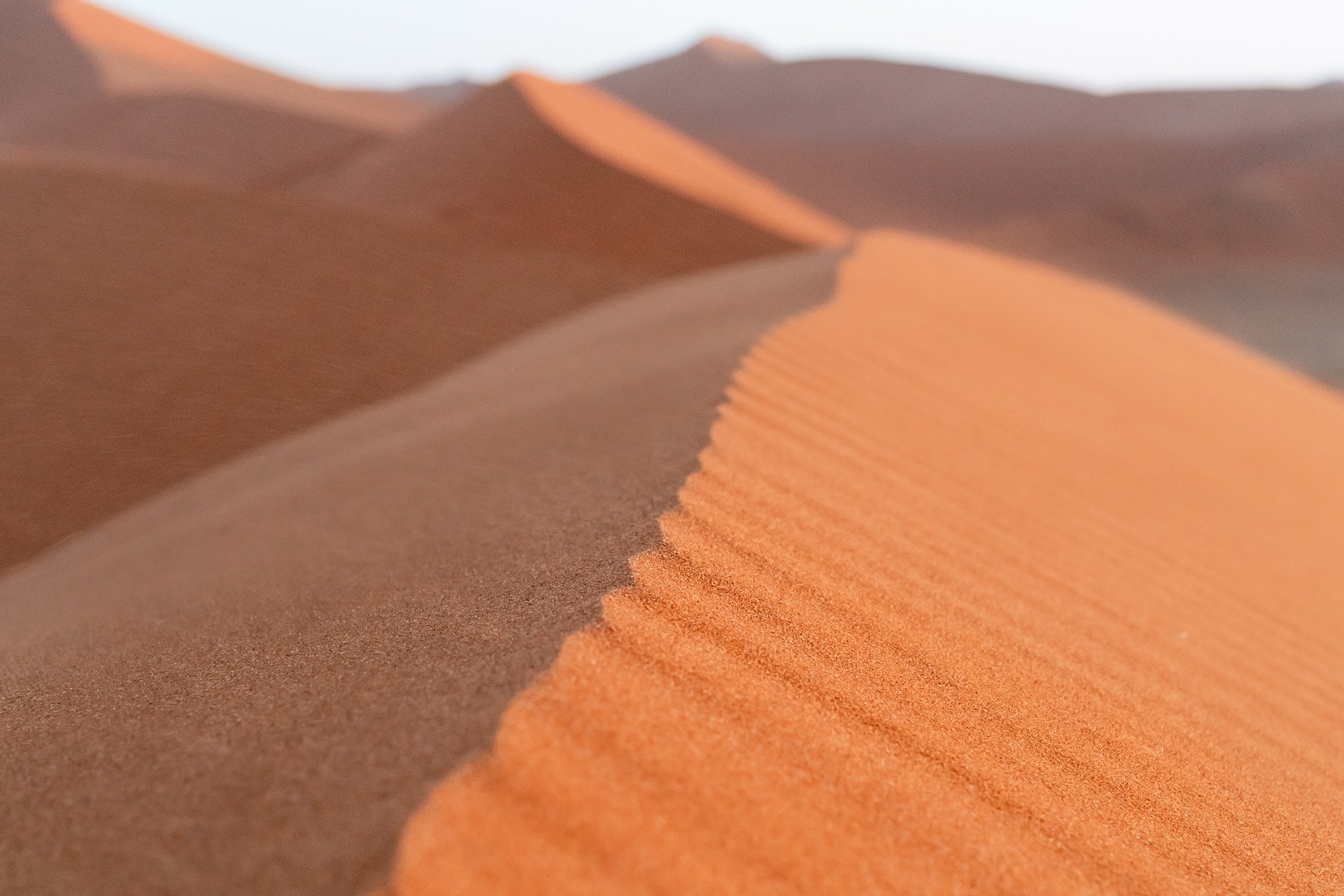
Sossusvlei ended up being one of my favourite parts of Namibia. And Lars didn’t hold back on the “I knew best” smirks on more than one occasion.
The red dunes, with their shifting shadows and the haunting images of dead vlei, are so incredible that you cannot help but be mesmerised by them.
In Short …
There are so many reasons to visit Sossusvlei, but if you love photography – this is one place you definitely won’t want to miss.
Want to see our driving route through Namibia? Take a look on our Polar Steps to see exactly how we traversed this stunning landscape.
Embarking on a road trip to explore Namibia’s wonders? Our Road Trip Tips for Couples will ensure you and your partner have a smooth and memorable journey.
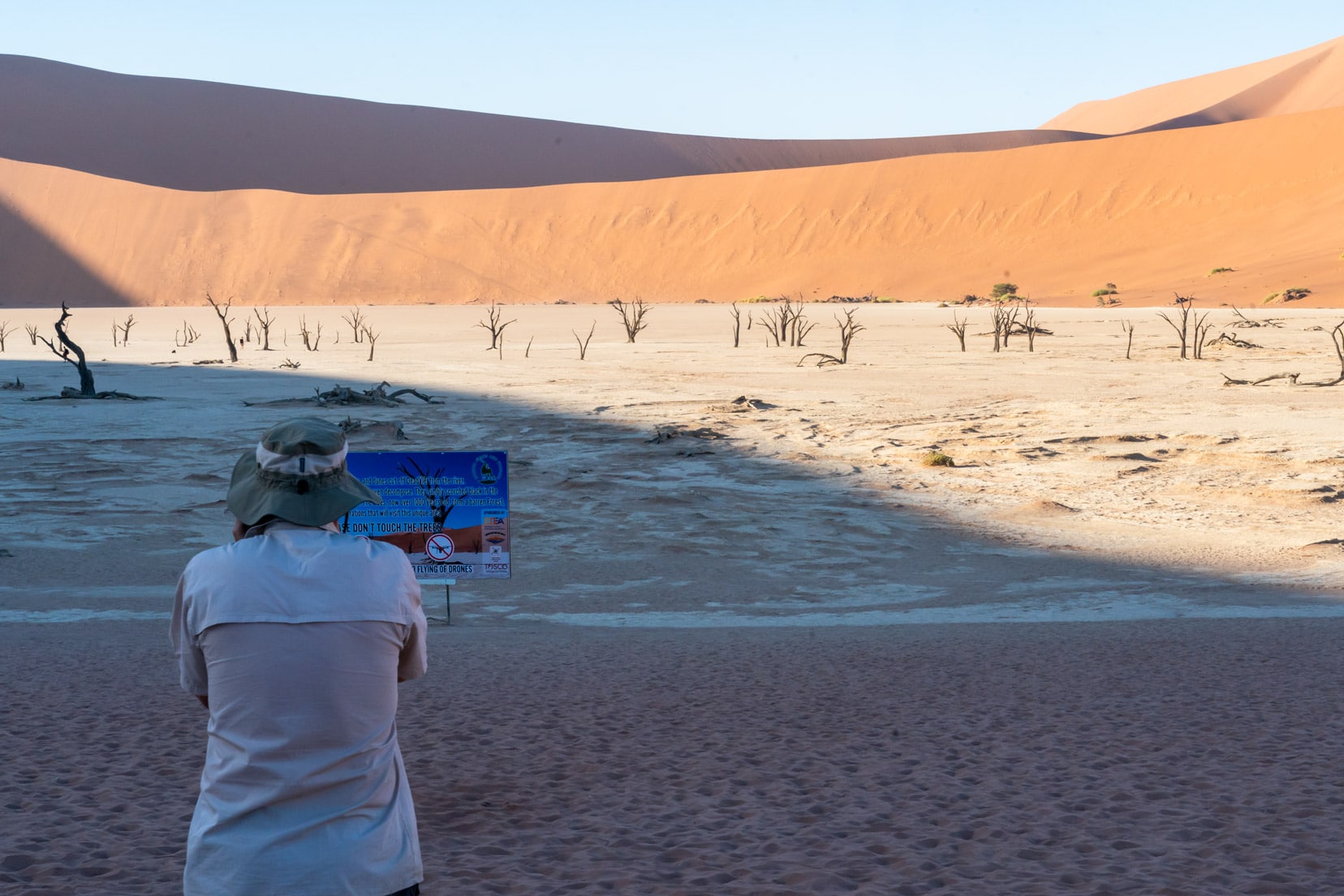
Why is it Called Sesriem Canyon?
The canyon’s name, Sesriem, comes from the early Afrikaans explorers who used six (ses) leather straps (riem) tied together to draw water from the riverbed. This historical tidbit adds to the allure of the canyon, making it an interesting addition to your explorations in the Namib-Naukluft National Park.
Whether you hike the entire length or just a part of it, Sesriem Canyon offers a unique and memorable experience amidst the arid beauty of Namibia.
Best Time of Year to Visit Sossusvlei
The best time to visit Sossusvlei is during the cooler and dry winter months, from May to October.
This period is often regarded as ideal due to several factors:
Comfortable Weather: The weather during these months is comfortably cool, which makes exploring and photography more enjoyable. The cooler temperatures are especially advantageous for activities like dune climbing, as the midday heat in the warmer months can be quite intense.
Enhanced Visibility and Photographic Conditions: The crisp, clear air during this period enhances visibility, making it perfect for capturing the striking red hues of the dunes against the clear blue skies. This is particularly appealing for photographers who wish to capture the stunning landscape of Sossusvlei.
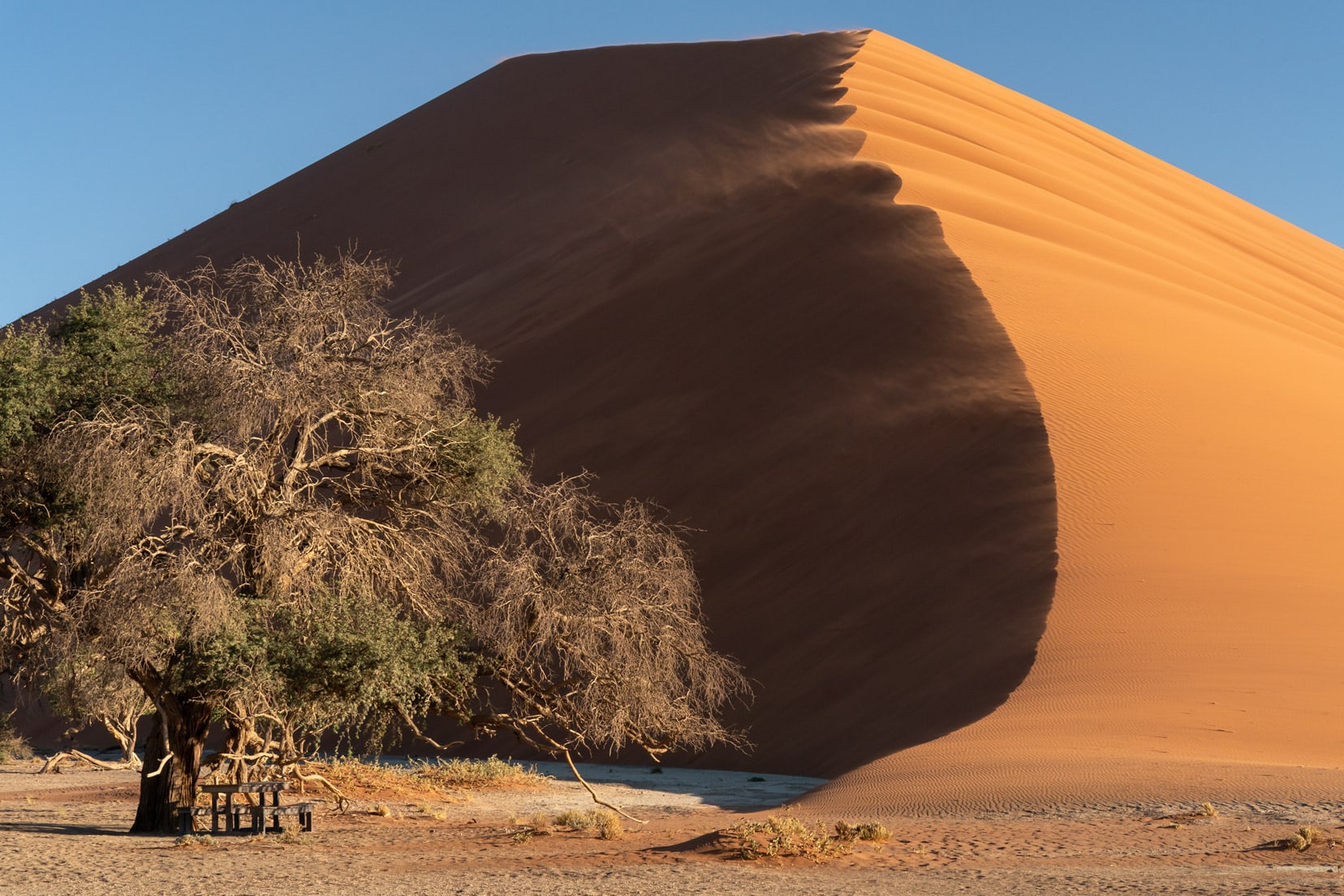
Dry Season Advantages: Visiting Sossusvlei during the dry season, which includes the winter months, means clear skies and sunny weather, creating ideal conditions for various outdoor activities.
Peak Tourist Season: These months also constitute the peak tourist season in Sossusvlei. While this might mean more visitors, it also indicates that it’s a favourable time for many to experience the desert wonderland.
However, strong winds in August make for more challenging conditions.
Our Experience
We visited Sossusvlei in March, and the campsite was windy in the afternoon, so I’m not sure I’d want to be there in August.
The average weather throughout the year is always warm in the daytime, but early morning can be particularly cold in winter. Even in March, an hour and a half before sunrise, the temperature was chilly.
In fact, at the dunes, other travellers were complaining about the cold. So whenever you visit, have several layers of clothing to combat temperature variations.
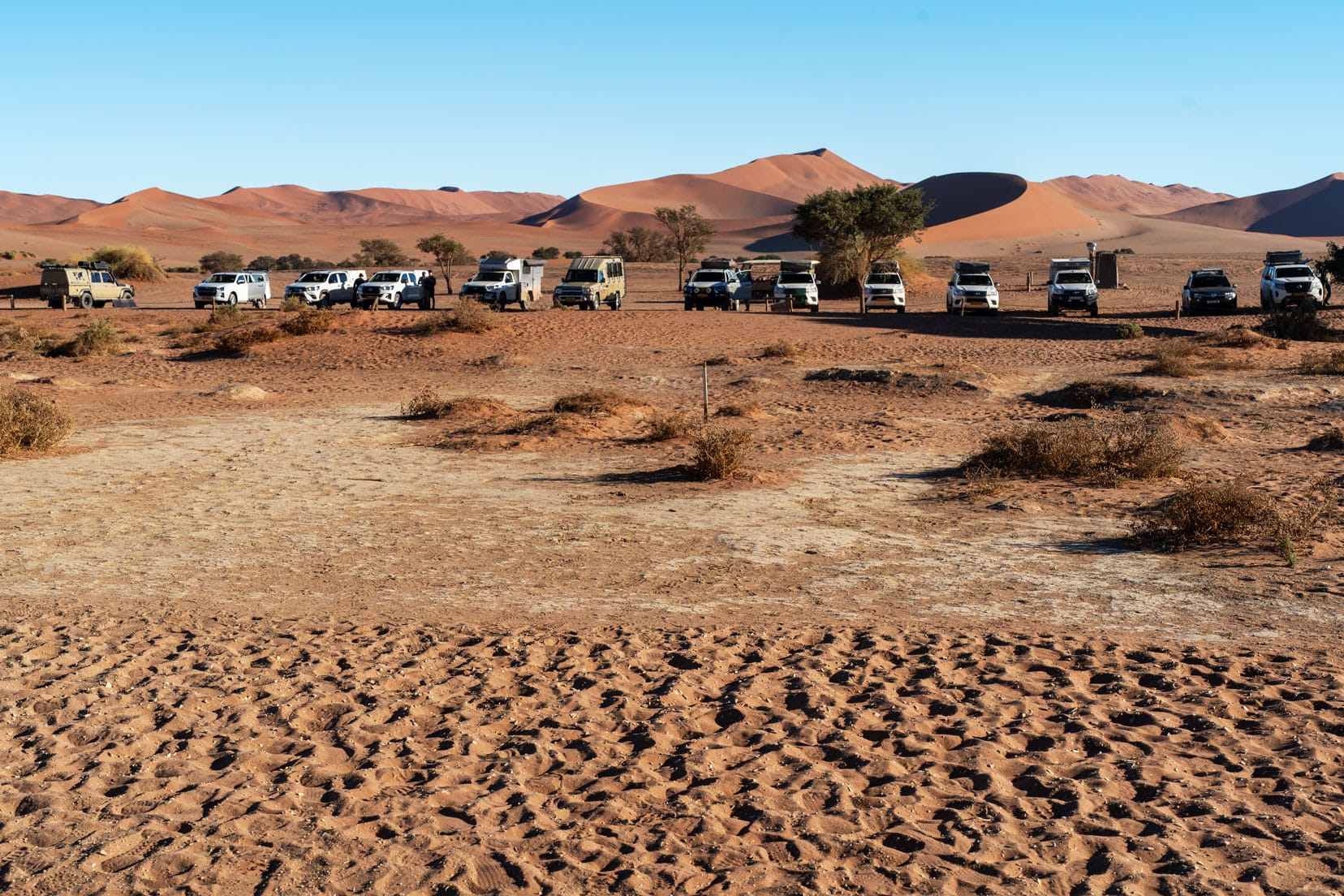
How Long to Stay in Sossusvlei
We stayed at Oshana Camp for two nights, and that was enough time. You could stay one night, but if you love photography, we’d recommend an extra night to increase the chances of experiencing different lights at various locations.
Our Sossusvlei Itinerary
Day One:
- We arrived on the 27th of March (driving from Kanaan Desert Retreat Campsite) at about 2.30 pm. We visited Elim Dune and then watched the sunset at Dune 45.
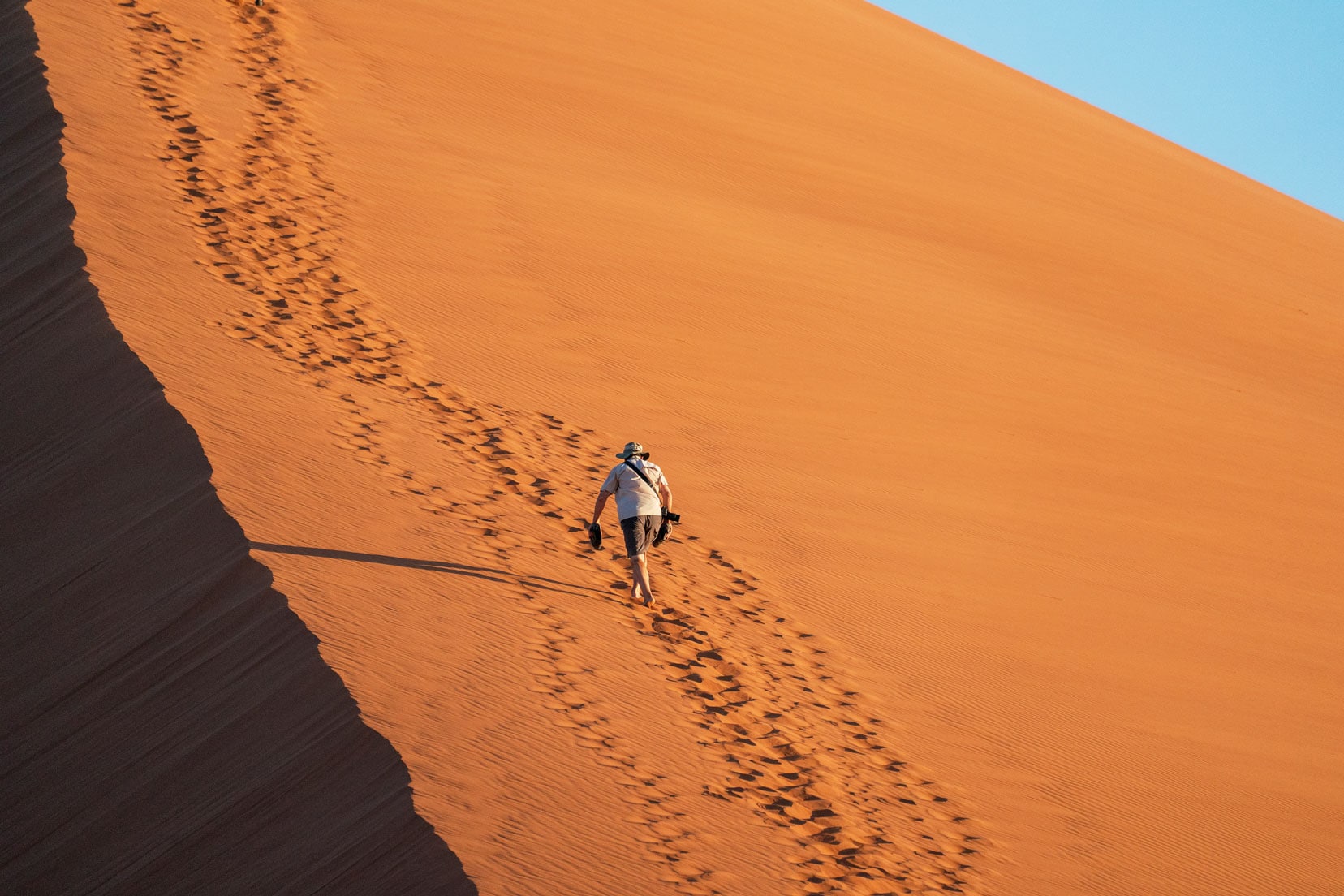
Day Two:
- We arrived at Second Gate an hour before sunrise and drove to Sossusvlei.
- On the last 5km 4WD sandy part, we got ourselves bogged! Luckily, a shuttle came by, and as we didn’t want to miss the sunrise, we paid for a lift and left our camper where it was.
- We walked to Deadvlei and spent the whole morning there until around 10.30 am when it became hot. We caught the shuttle back to our bogged camper, then headed back to camp.
- Late afternoon, we went to Sesriem Canyon – it was around 4.30, but temperatures were still in the high 30s, so we didn’t walk the whole 1 km length.
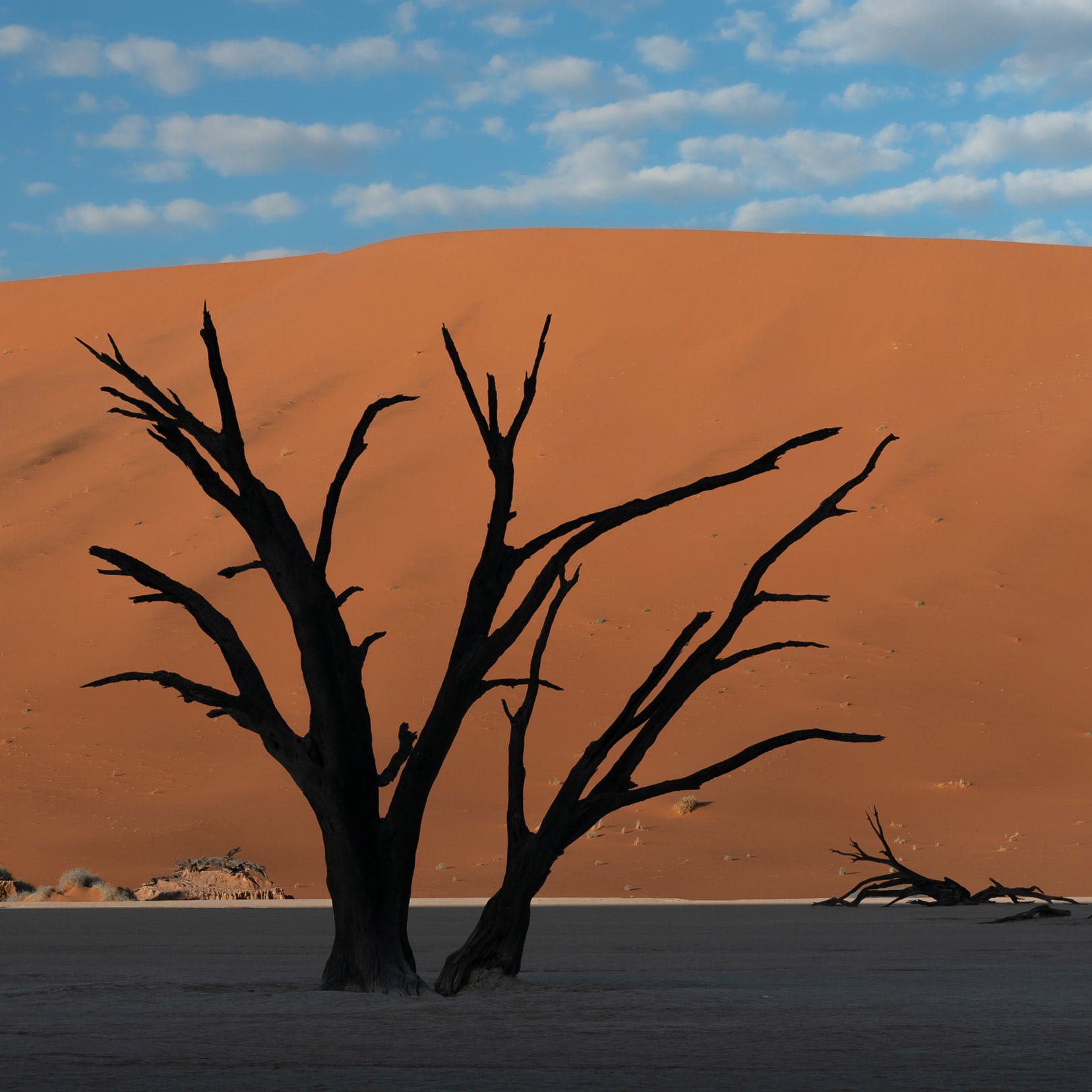
Day Three:
- We woke up early again to be at the Second Gate as it opened an hour before sunrise and drove to Sossusvlei again – this time stopping in the 2×4 car park to let our tyres down enough to drive the 5km without getting bogged!
- We walked to Deadvlei again.
- Afterwards, we drove on further to Big Mama’s foot and Sossusvlei’s salt and clay pan.
- Arrived back at camp to check out by 10.30 am
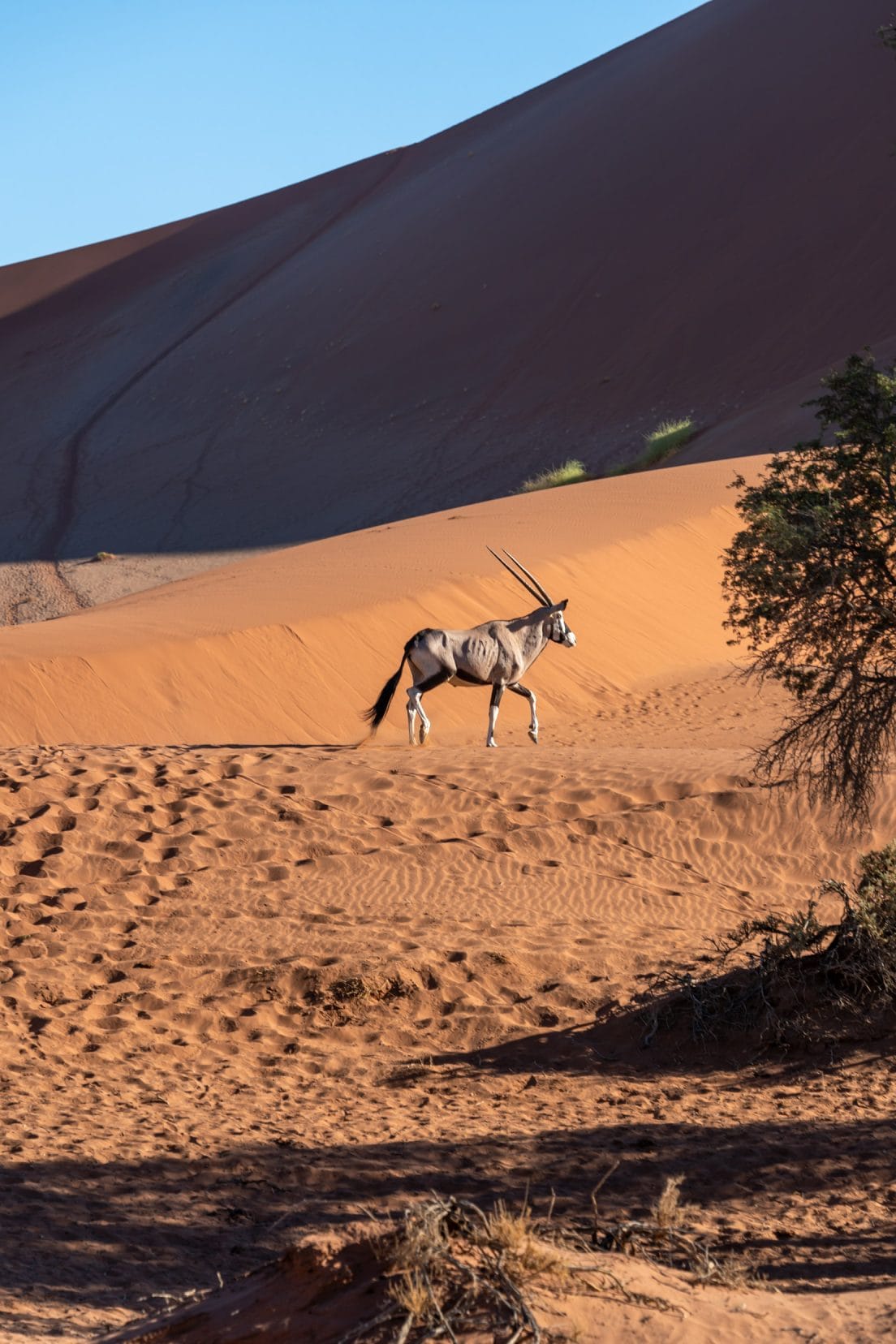
Sossusvlei FAQs
What are the main attractions in Sossusvlei?
The main attractions of Sossusvlei include the famous Dune 45, Big Daddy, Deadvlei, and the mesmerizing pan at the heart of the region. Additionally, the area offers opportunities to spot wildlife such as oryx and ostrich.
Where can I stay when visiting Sossusvlei?
Various accommodation options are available near Sossusvlei, ranging from luxury lodges to campsites. For a more immersive experience, visitors can also stay inside the Namib-Naukluft National Park.
Is a sunrise visit recommended in Sossusvlei?
Absolutely! Witnessing the red dunes of Sossusvlei at sunrise is a breathtaking experience and a must-do for visitors. The play of light and shadow on the dunes creates an incredible visual spectacle.
Can I take a safari in Sossusvlei?
While Sossusvlei is not known for traditional safaris with the Big Five, it offers its unique desert safari experiences. Guided tours and drives are available for visitors to explore the area and its natural wonders.
Why are the Sossusvlei sand dunes red?
The sand at Sossusvlei has built up over 5 million years. Over such a long time, the iron in the sand becomes oxidised, forming a red/orange colour, much like the rusting metal.
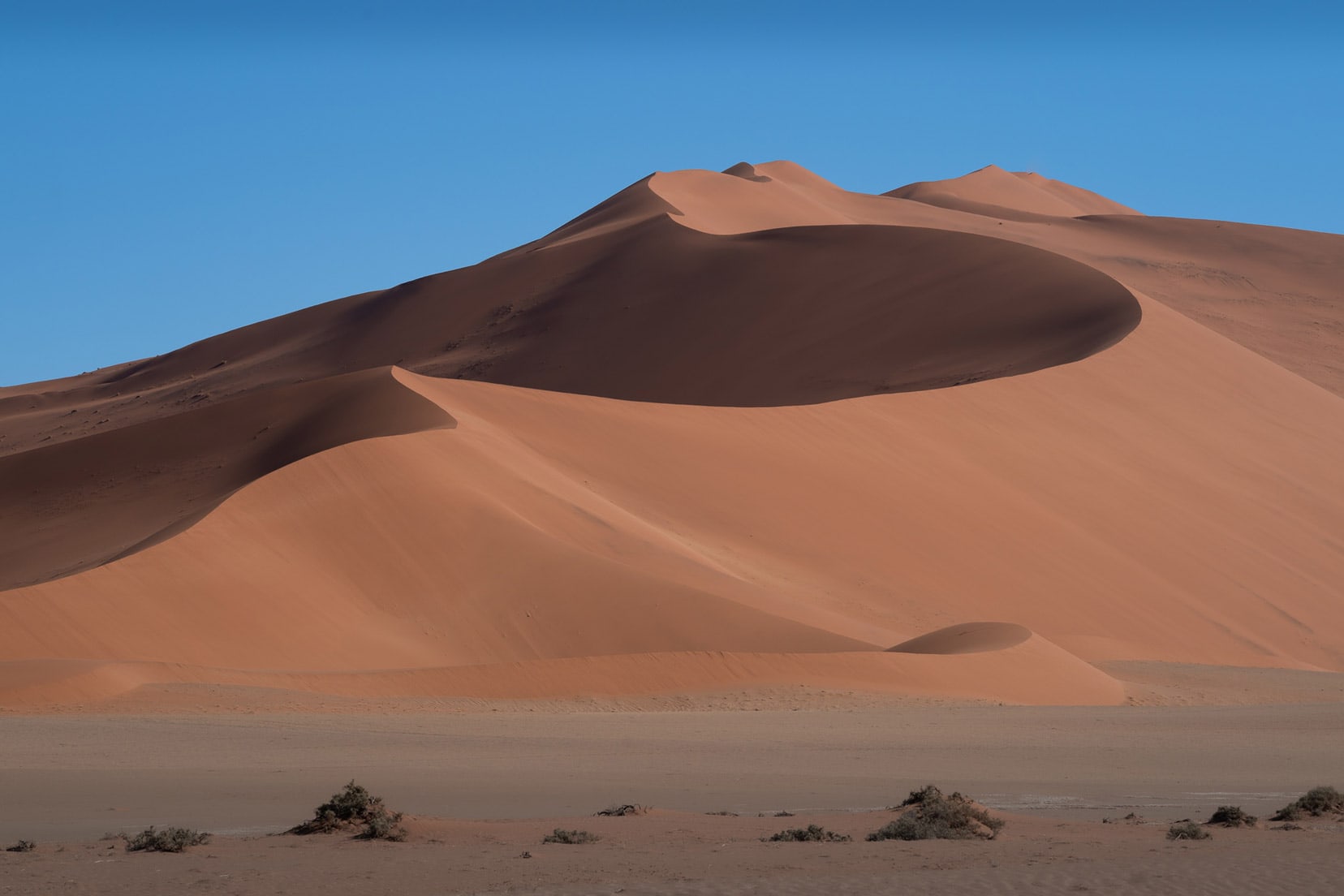
Visiting Sossusvlei and Sesriem Canyon… That’s a Wrap
Our journey through the enchanting landscapes of Sossusvlei and Sesriem Canyon was nothing short of extraordinary.
Whether you’re a photography enthusiast, a nature lover, or just seeking a unique travel experience, Sossusvlei offers a mesmerizing array of sights and activities.
We hope our guide, crafted from our personal explorations, inspires your own journey into the heart of Namibia’s desert wonderland.
If you are planning a road trip in Namibia, make sure you download our Free Road Trip Planner here ⬇️
If you’re looking for road trip inspiration, you might enjoy our collection of inspiring road trip quotes.
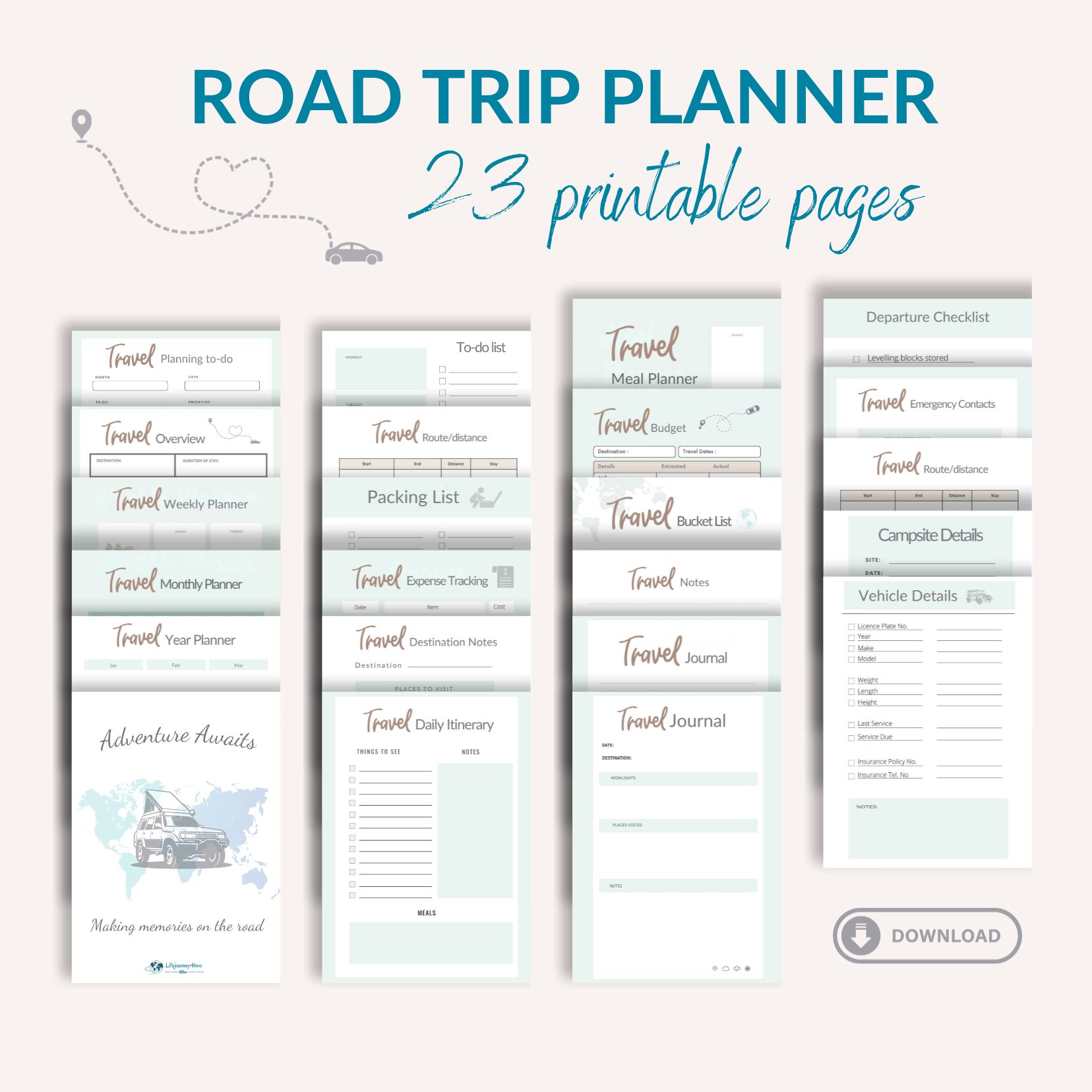
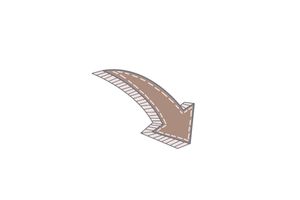
Pin and Save for Later
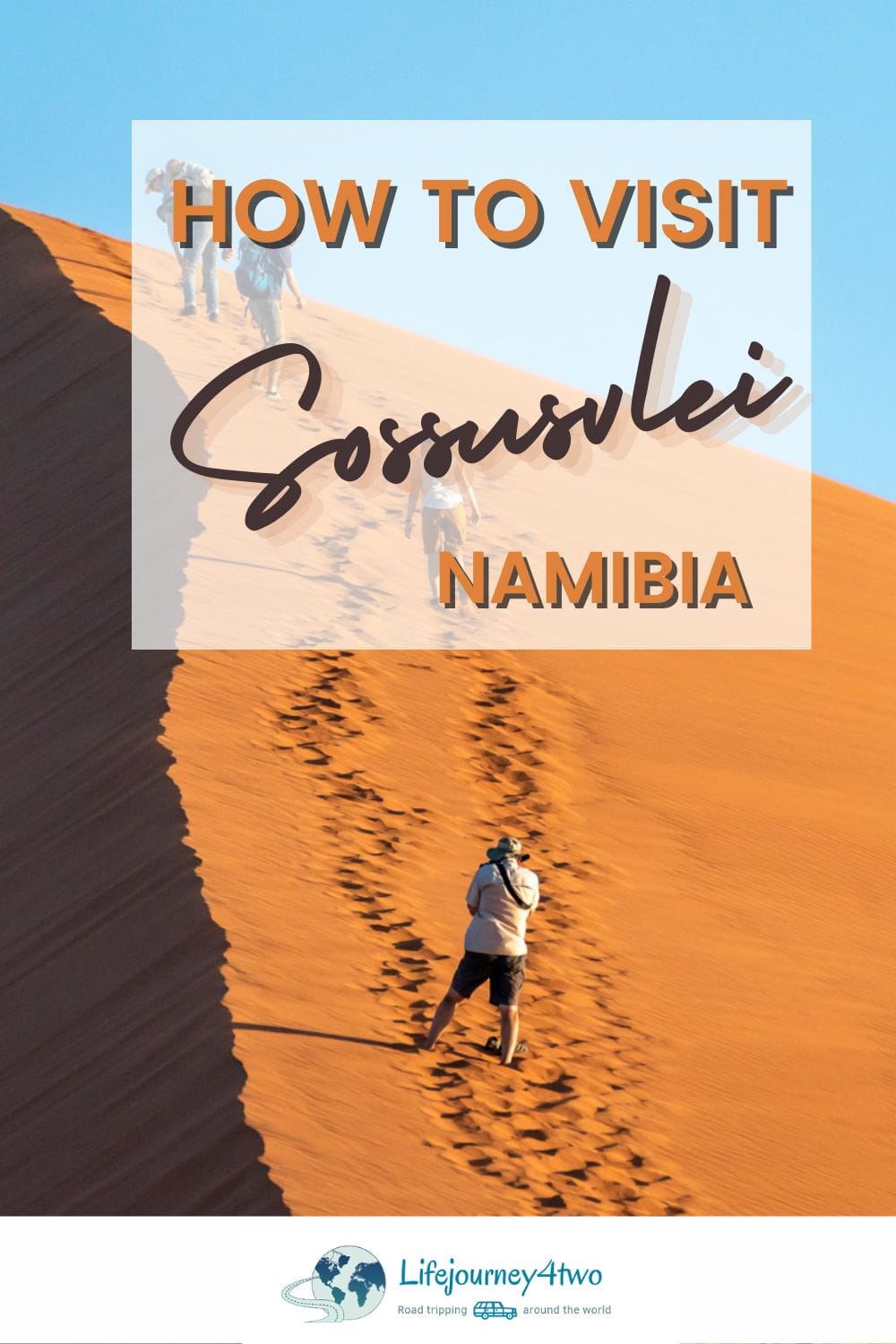
Planning Your Travels?
These are the travel resources we recommend and use when planning our trips.
- 🚘 Car Hire: We use DiscoverCars.com
- Motorhome/Campervan Rental: We highly recommend the Motorhome Republic
- 🪪 Order your International Driver’s Licence online here
- 🛏 Book Accommodation: We use Booking.com to find accommodation that suits our budget
- 🐶 Pet Sitting/Pet Sitters: Check Out TrustedHousesitters here (Use our Discount code: LIFEJOURNEY25 for 25% off. )
- Activities and Experiences: Get Your Guide and Viator
- Travel Insurance: Safetywing or World Nomads
- 🥾 Travel Gear and Accessories: Check out our top picks here — Lifejourney4two page on Amazon
For a more thorough list, visit our Travel Resources page here.

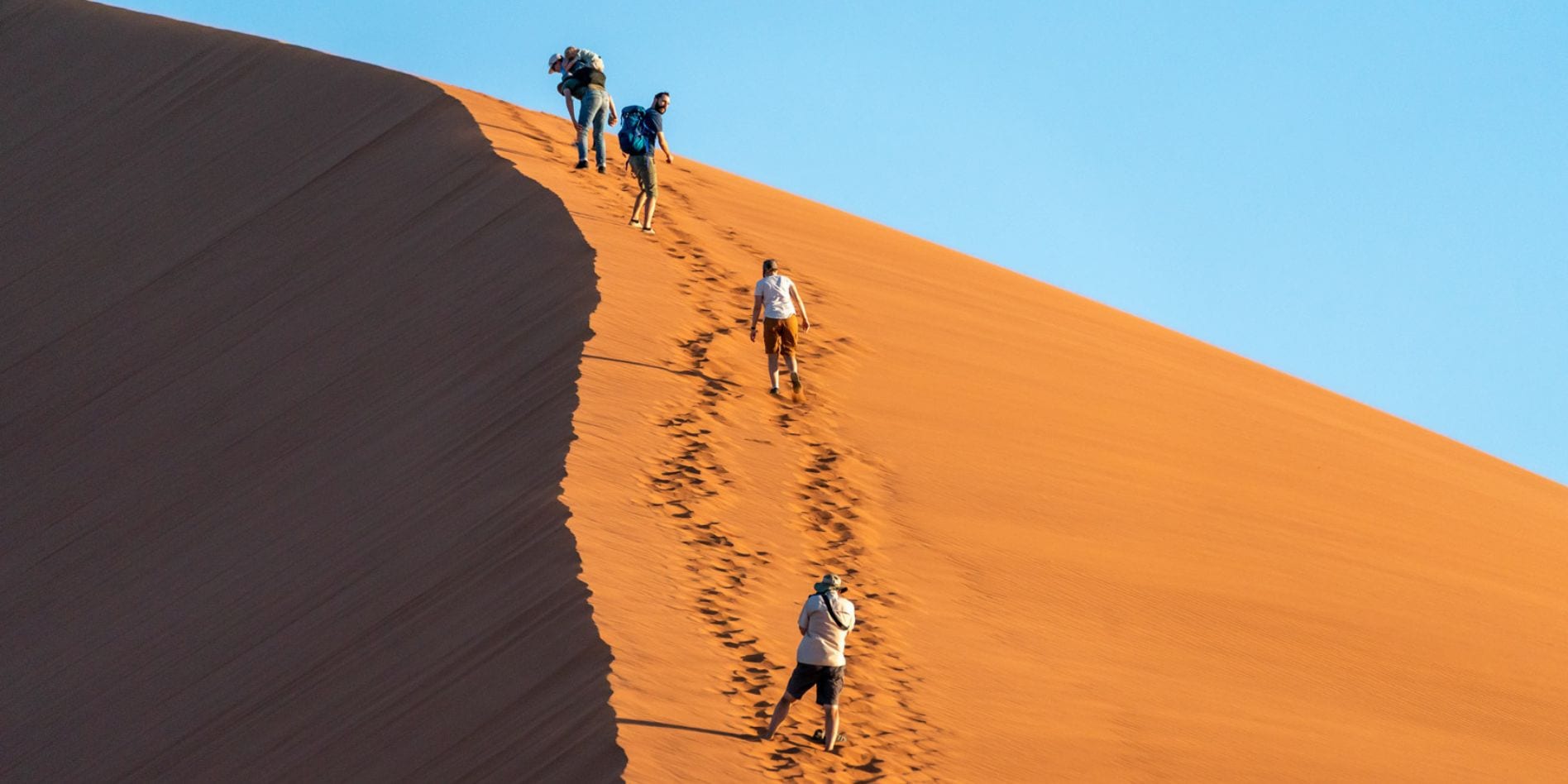
Super comprehensive blog post Shelley, loved it, we are heading there next month for a couple of nights. I am from South Africa and just one correction I thought I’d let you know about is, Dead Vlei means Dead Lake, not Dead Valley. Great post!
Thanks so much Raoul, and so pleased you loved the post. I actually knew that it meant lake so no idea why I’ve put valley – vlei sounds too much like valley I guess;) Thanks for taking the time to comment – it’s really appreciated. And have a fabulous trip next month. Would love to see your pics.
Thanks again
Shelley